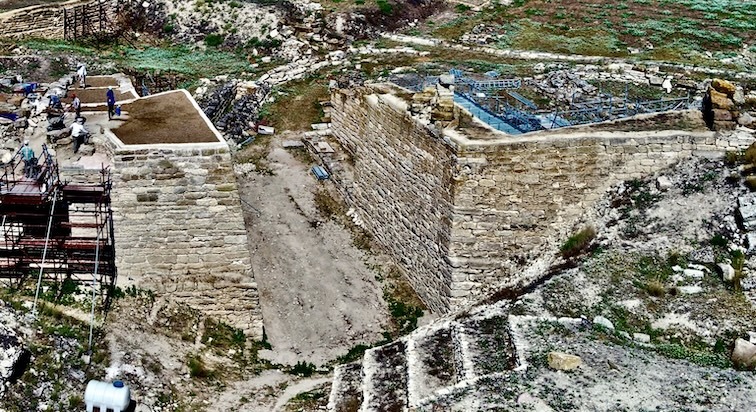
This article is available to Premium members of Popular Archaeology.
Become a member or upgrade to a Premium membership: REGISTER HERE.
Member Login:
This is the example article

This article is available to Premium members of Popular Archaeology.
Become a member or upgrade to a Premium membership: REGISTER HERE.
Member Login:
Professor Frank J. Korn has retired from his teaching position on the Classical Studies faculty at Seton Hall University. He is a Fulbright Scholar at the American Academy in Rome and the author of nine books on various aspects of the Eternal City. He is listed in Marquis Who’s Who as “a notable classical educator and writer.” Recipient of the Princeton Prize for Distinguished Teaching, he resides with his wife Camille in Scotch Plains, N.J. The couple’s three sons – Frank, Ronald, and John and their families live nearby. His latest book – Below Rome, the Story of the Catacombs – which he co-authored with his wife, is available on Amazon or from the publisher, St. Johann Press, Haworth, N.J.

Here with A Loaf of Bread beneath the bough
A flask of Wine, a Book of Verse – and Thou
Beside me singing in the Wilderness
And Wilderness is Paradise enow.
—OMAR KHAYYAM
In the minds of people who have been there, many things are readily associated with Rome: churches and cafes, pines and cypresses, courtyards and piazzas, fountains and ruins. The image most often associated with Roman cuisine, however, is that of bread and wine. In the Eternal City, not a table is set without both.
Both elements have, since antiquity, carried an almost spiritual connotation for the Romans and their fellow Italians. Since bread is made from many grains and wine from countless clusters of grapes, each stands for unity. In the churches of Rome, the sacramental bread and wine become emblems of brotherhood and love. During this Jubilee Year of A.D. 2025, pilgrims by the millions will approach the altar rails of Rome’s Catholic churches to receive the bread and wine of communion which Roman Catholics believe to have been consecrated into the body and blood of Christ.
Some Romans even see bread and wine sharing a natural nine-month cycle and kinship with man and woman. It takes nine months from the time the grain is sown in November until it is reaped and threshed in July to be ground into flour and made into bread. Before wine can be made, the grapes must be allowed to ripen from March to November. And, of course, the miracle of human birth also requires a period of nine months.
In very early Roman times, bread was produced at home through a laborious task of grinding grains of wheat into flour with a mortar and pestle. By the late Republic, the mola versatilis (rotary mill) had been invented, spawning the growth of commercial bakeries. In 1862, excavators unearthed the baking establishment of a man named Modestus, featuring large brick ovens, along with sturdy stone mills for grinding the wheat, and various tools for the making of bread.
This archeological work in Pompeii also yielded loaves of bread, intact but carbonized, giving us an idea of size, shape, weight, and other factors. The typical loaf was round, about twelve inches in diameter, five inches in thickness and one pound, or so, in weight. Curiously, there was a hole in the center, somewhat like our modern coffee cake, and cut into eight pie-wedge-shaped mini-breads.
Panis, bread, quickly became the Roman dietary staple, comprising sixty percent, or more of a person’s main meal of the day (prandium) and a good measure of the breakfast (jentaculum) and evening’s light meal (cena). A typical vignette at a worksite back then – and to this day – remains a group of laborers on a break, each feasting on a thick chunk of bread, washed down with a flask of vinum. (Today these workers are often spotted wearing makeshift hats, made from brown paper bags, to ward off the blazing sun.)
There were several varieties of bread turned out by the city’s myriad bakeries. Panis testutis was a pot bread baked in the oven, while panis artopicius was a pan bread, cooked on top of a stove. There was seeded bread, sponge bread, whole grain, and cake bread. The prevalent variety was the lightly salted panis quadratus, as found in the Pompeii and Herculaneum digs. In his magnum opus, Historia Naturalis, Pliny the Elder discusses bread and bread-making at length, and has lofty praise for the product as being excellent for one’s physical well-being.
The journalist Stacy Nick writes, in one magazine article, of an archeology professor—Emily Wilson at Colorado State University—who seeks to show her classes just how much like us were the ancient Romans. One student was so taken by the Prof’s lecture on the bread of old Rome that she, Kayla Spahr, went back to her dorm and baked a loaf of panis quadratus, guided by Pliny’s words and by pictures of the loaves discovered in Pompeii. Wilson contended that the ordinary Roman men of that long ago era who made up the labor force for building the elaborate public monuments, used bread as the main item of their daily diet. She liked to say: “Bread was the substance that built Eternal Rome.”
______________________________
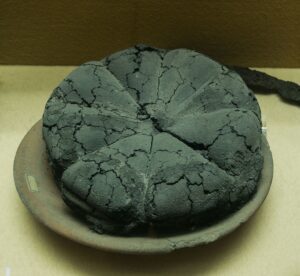
Ancient roman bread, year 76 or 79 CE, from Pompeii, Italy. Jebulon, CC0 1.0 Universal, Wikimedia Commons
______________________________
Bread prices were very reasonable and well within the budgets of even families of meager means. The very poor received subsidized or free grain from the city’s welfare program known as the Cura Annonae (named for Annona the goddess of the grain supply). The satirist Juvenal (A.D. 55-130) mocked the government’s domestic policy as one of “Panem et Circenses,” free bread and free spectacles, as a way of keeping the restless rabble in check by ensuring that their stomachs were always full and their minds distracted. Pliny the Younger lobbied for free books instead of free shows in the arenas.: “Ut panis ventrem sic pascit, lectio mentem,” he would argue: “Just as bread nourishes the body, reading feeds the mind.”
The poet Horace was more mundane on the subject: “Cum sale panis latrantem stomachum bene leniet,” i.e. Bread with salt is enough to calm the stomach that growls.
From the Latin word panis, we English-speaking peoples derive our terms “pantry”, where bread is stored, and “companion,” someone you break bread with.
When setting the table for an elegant dinner party the host would want to be sure that wholesome and delicious bread was included. Bakers could be hired out for such soirees. (Loaves of bread would make for nice gifts to the dinner guests when leaving.) There remains in Rome a street called Via Panisperna. This derives from a tradition in the Middle Ages where an order of the Friars of San Lorenzo daily toiled in distributing to the poor, panis et perna, bread and prosciutto.
Bakers were held in high esteem by the general populace for providing the “staff of life.” They were, at times, the subject of paintings and mosaics. There is a remarkably preserved mural in Pompeii showing a baker behind the counter in his shop, that is stocked with countless wheel-shaped loaves, selling his product to eager customers. Near the central arch of the Porta Maggiore is the elaborate tomb of Eurysaces and his wife Atistia, proprietors of a bread making establishment of the first century B.C. The tomb was discovered during an urban renewal project in 1838. The frieze carvings represent the various phases of producing bread. One relief shows slaves, in tunics, being supervised in their work by the toga-clad owner. Another shows a scale for measuring the weight of the grain, another a sieve for the flour, and yet one more showing the placing of the dough in the oven.
_____________________________
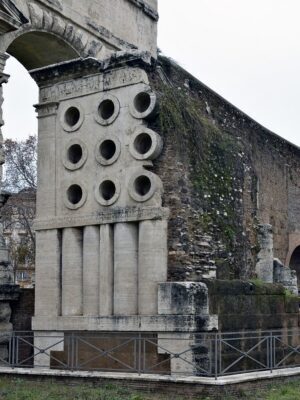
Above and below: tomb of Eurysaces the Baker. Livioandronico2013, CC BY-SA 4.0, Wikimedia Commons
_____________________________

Frieze detail
_____________________________
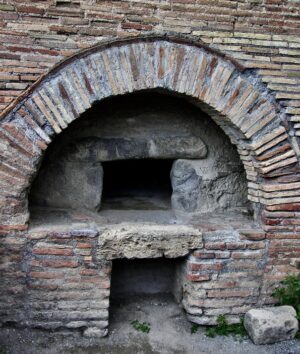
Bakery oven excavated in Pompeii. Wknight94, CC BY-SA 3.0, Wikimedia Commons
_____________________________
…….
As for wine? Pliny covers the subject extensively in Book XIV of his encyclopedia. So too does the contemporary author Luigi Devoti, provide us with information. It existed in Italy long before Rome was founded. Archeological evidence clearly shows that the Etruscans were producing and drinking wine throughout the regions of Tuscany and Lazio as far back as the tenth century before Christ. The ancients believed wine to be of divine origin, a gift to mortals from some deity: Fufluns for the Etruscans, Osiris for the Egyptians, Dionysius for the Greeks, Bacchus for the Romans.
Marcus Porcius Cato, in his book De Agri Cultura, tells us that the planting of the vine was introduced into the city of Rome by its second king, Numa Pompilius (714-671 B.C.). This seems to be corroborated by the existence of wine jugs dating back to that time that have been discovered in very ancient tombs in the Roman countryside. Up to that time, the Romans had access only to imported wines. At first local winemaking was scarce but, by the third century B.C., Roman vineyards were to be found not in the city itself but in the surrounding hill country. The wine called Albanum came from the various communities of the Alban Hills, e.g. towns we know today as Albano, Castelgandolfo, Frascati, Nemi Grottaferrata, Marino, Rocca di Papa, and Velletri, and from slightly more distant areas like Formiae, Sabina, and the regions of Campania and southern Lazio.
Romulus, the first king of Rome (753-714 B.C.), and his subjects used to invoke the blessings of their gods with incense. With the spread of viniculture in later centuries the deities were worshipped, Pliny the Elder says, with the sacrifice of lambs and pigs, along with the smoke of incense and aspersions of wine.
…….
Wines were distinguished according to their taste: sweet (vinum dulce), smooth (vinum suave), weak (vinum fugiens), full-bodied (vinum solidum), bitter (vinum acutum), and so on. Wine came in various colors: white (album), blond (fulvum), blood-red (sanguineum), dark red (rubrum), purple (purpureum).
By the last Republic and early Empire – first century B.C. and A.D. – wine had become the lifeblood of Roman social and domestic life. From writings of that epoch we learn that Cicero loved a wine called Falernum, a dry red from Campania. One host of frequent dinner parties, given to exaggerating the age of his wines to impress distinguished guests, told Cicero that the Falernum being served that particular evening was very aged: “Bibe hoc vinum quadraginta annorum!” (Drink this wine, aged for forty years.) After one sip, Cicero wryly commented, Bene aetatem fert. (It carries its age well.)
Vergil favored Vinum Rhaeticum, a light wine from the region around his birthplace of Mantua; Horace enjoyed Vinum Calenianum, a ruby red from the vineyards near Tibur (modern Tivoli). The poet/satirist often invited his patron Maecenas to dine at his villa out in that hilltown. On one occasion he excitedly sent this invitation to the gentleman:
“Tibi non ante lene merum cade iam dudum apud me est.
Eripe te morae!”
An amphora of excellent untapped wine awaits you here at my place.
Try to break away and come over soon!
Vinum Caecubanum came from a small marshy territory on the coast of Latium (Lazio), overlooking the Tyrrhenian Sea. Elder Pliny hailed it as “noble and wonderful.”
Pliny also points out that Vinum Setinum from the Alban Hills was the preference of the Emperor Augustus:
“Divus Augustus Setinum praetulit cunctis.”
(Augustus used to say that this vintage should be reserved for the table of Bacchus himself.) This was a dry, white wine, light bodied and refreshingly fruity, much like the immensely popular Frascati, found on virtually every restaurant table in Rome these days. As Pliny used to say: “Those hills are clothed with vineyards, whose grapes provide a juice lauded throughout the world.” (From this comment we can plausibly infer that, by then, Roman vintners were heavy into the export business.)
There is in Pompeii a tavern mural showing two men, one with a jug, the other holding a cup. The caption reads, “Adde calicem Setinum’. Another cup of Setinum, please.
In the very early times of King Numa, only the men were allowed to indulge in the fermented grape, because there was a widespread superstition that its consumption could render women infertile or cause an abortion. This rule was ultimately lifted and soon after even the children were being permitted to have a watered-down version of the alcoholic beverage. The alcoholic content of the local wines, incidentally, generally came to about thirteen to fifteen percent. As a result, some adult males were known to prefer mixing with aqua, so as to avoid intoxication. The playwright Apuleius cautioned thus:
(Prima creterra ad situm pertinet, secunda ad hilaritatem, tertia ad
voluptatem, quarta ad insaniam!” The first glass has to do with thirst,
the second with fun, the third with pleasure, the fourth with madness!
Everyone is familiar with Pliny’s observation…”In vino veritas” – in wine there is Truth. But few know the second part of that gentleman’s statement … “In aqua Sanitas”… in water there is Health. A proverb in that era stated:
“Intemperantia medicorum nutrix” – Lack of restraint keeps doctors wealthy. (Yet, some physicians were of the opinion that a robust red wine was good for the blood.) The poet Ovid scoffed at the intemperance warning. He insisted: “Cura fugit multo diluturque mero.” (Good wine drinking diminishes cares and woe.)
At first, the Romans’ consumption of wine was confined to the privacy of one’s home, where even the slaves of affluent families were given a daily ration of a pint or so, especially those assigned to extremely laborious tasks. The military, too, had a similar arrangement with each soldier being issued a daily allotment of one liter. On days of maneuvers, of marches, and of combat, the wine given to the men was in a much watered-down form.
But in due time, wine began to be sold in public places. The most common of these were the cauponae, or inns, often located along the main highways. Later on, taverns started sprouting in the city itself. The Romans knew such a place as vinarius, for drinking at the bar or for take-outs. Rome was in love … with vinum. That wine was plentiful and popular was attested to by the discovery of large terracotta (i.e. clay) jug-eared amphorae each of which held about 26 liters which would be approximately seven gallons. A full amphora weighed around a hundred and ten pounds. There is, just off the Forum in excavated Pompeii, an emporium stacked with such containers, clearly visible to the passerby.
___________________________
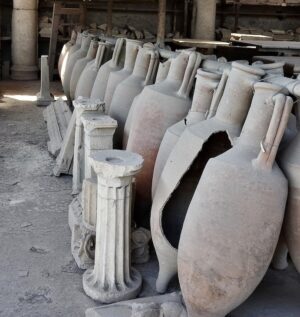
Amphorae, Pompeii. Rob Mitchell, CC0 1.0 Universal, Wikimedia Commons
___________________________
In time, the Roman wine-dealers adopted the oaken barrel which they learned about from the Gauls and which proved to be better for aging the wine and easier to transport (since they were rollable).
Lest we feel that wine always came in only such large vessels, it should be pointed out that in private homes it was stored in much smaller and lighter earthen jugs and sometimes in glass bottles holding about a liter and a half.
The wine industry continued to flourish. By the first century of the Christian era, Rome was awash in wines both domestic, and imported from such far off lands as Gaul, Spain, Greece, Illyria, Egypt, and Asia Minor (modern Turkey). In that very century the prominent Roman writer Marcus Terentius Varro turned out a work of twelve volumes on agriculture (De Re Rustica). He devoted much of one volume to promoting viticulture, encouraging his readers to buy farmland to turn into vineyards. He advised that “no ground, even the most unfavorable, will fail to yield a return far exceeding the initial investment.” Pliny the Younger remembered these words and in his retirement, after a distinguished career in government and in writing, invested in extensive property in the region of Etruria, (most of which is now Tuscany). Sure enough his vineyards yielded a great annual harvest which in turn produced an abundance of wine of good quality. His sprawling country terrain ultimately paid for itself hundreds of times over his original expenses. A leading vintner, Pliny shyly admitted that more people were buying his wine than reading his books, essays, and letter collections. His aim was to bring down the average price of wine. “The poor,” he insisted, “deserve it as much as the rich.” In this, he largely succeeded.
____________________________
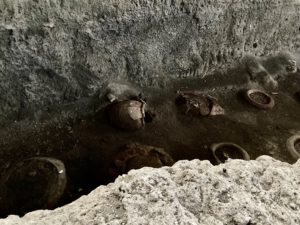
Wine storage vessels excavated in situ within the massive Villa Augustea, Dionysiac Villa, located near Somma Vesuviana, a town on the north side of Vesuvius.
____________________________
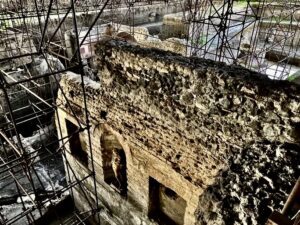
The “Villa of Augustus”, or the Dionysiac Villa, was known as much as a production facility for wine as it was a grand villa.
____________________________
From these ancient beginnings, bread and wine have remained the staples of the Italian diet across the ages. In Rome and all through the boot-shaped peninsula, wine has never been a guarded beverage to be found only in the homes of the affluent. A blue-collar family picnic under a cool umbrella pine out on the Appian Way is certain to include a straw-encased flask of dry wine, rosso or bianco, as well as a wheel-sized loaf of pane. A decanter of wine is ever present on the table of the shepherd, the farmer, the carpenter, the merchant, the teacher, the priest, the nun.
And yet Rome does not seem to have a significant alcoholism problem, for having been given a watered-down taste of wine from childhood on, the vast majority of Romans know how to enjoy it in moderation. From time immemorial, Latin and Italian poets have sung the praises both of bread and wine. One writer says that bread is like a mother, in that we fail to fully appreciate it until we no longer have it. An old proverb insists that a lunch or dinner without wine is like a day without sunshine: “Una cena senza vino e come una giornata senza il sole.” Another puts it like this: “Sine pane et vino Amor esurit.” – Without bread and wine, Love goes hungry, The Italian toast: “Alla salute!” alludes to the health benefits of a drink or two.
Perhaps it is no mere coincidence that the most acclaimed novel to come out of Italy in the twentieth century, a poignant tale by Ignazio Silone, bears the title, PANE E VINO.
_____________________________
*Note: Some archeologists theorize that the first Roman vineyards were cultivated by Greek settlers in the sixth century B.C., on the fertile slopes of Mount Vesuvius, overlooking the Bay of Naples and its surrounding enchantments: Cape Miseno, the Cliffs of Sorrento and the romantic isles of Procida, Ischia, and Capri. An age-old legend tells us that it was Christ himself who got viniculture started there. Neapolitans have long described their breathtaking setting as “Un pezzo del Paradiso caduto sulla terra.” (A piece of Heaven fallen on Earth.) The legend claims that the Lord came down to see it for himself and climbed the slopes of the volcano for a better look. When Christ looked out over this scenic wonder, he wept, and where his tears fell, grapes grew, and from them came the wine that has been called, for centuries untold, Lacrima Christi, Latin for the “Tears of Christ.” This splendid wine was referenced in literature as far back as the 1500’s, in Marlowe’s work “Tamburlaine,” in Votaire’s “Candide”, in Dumas’ “The Count of Monte Cristo.” Romans have across the ages ordered bottles of it to mark special occasions.
Cover Image, Top Left: VesaL, Pixabay
Freelance writer, researcher and photographer, Georges Fery (georgefery.com) addresses topics from history, culture, and beliefs to daily living of ancient and today’s indigenous societies of Mesoamerica and South America. His articles are published online at travelthruhistory.com, ancient-origins.net and popular-archaeology.com, and in the quarterly magazine Ancient American (ancientamerican.com). In the U.K. his articles are found in mexicolore.co.uk.
The author is a fellow of the Institute of Maya Studies instituteofmayastudies.org, Miami, FL and The Royal Geographical Society, London, U.K. (rgs.org). He is a member in good standing with the Maya Exploration Center, Austin, TX (mayaexploration.org) the Archaeological Institute of America, Boston, MA (archaeological.org), NFAA-Non Fiction Authors Association (nonfictionauthrosassociation.com) and the National Museum of the American Indian, Washington, DC. (americanindian.si.edu).
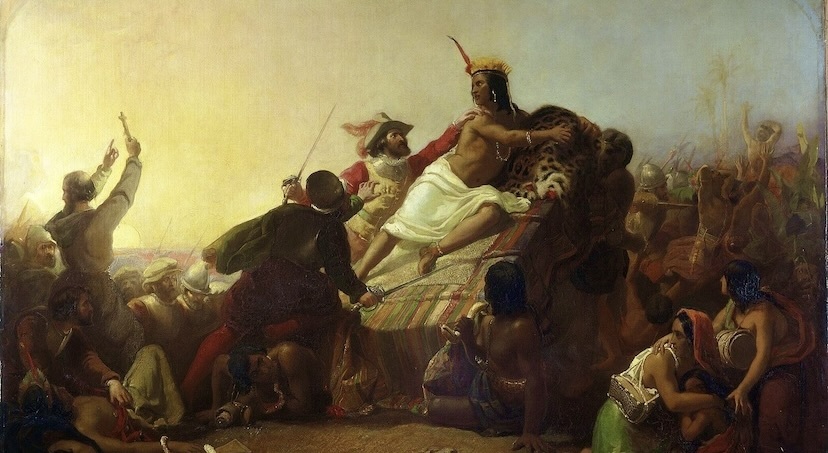
The conquest of Perú was not, as the word “conquest” implies, a grandiose affair with drums beating and banners flying. Quite the opposite; it was the unexpected outcome for the search for a way across the isthmus of Panama to the Pacific Ocean from the North Sea, today’s Caribbean Sea. At the time, no one could conceive that a South American continent existed.
The “conquest” started with Vasco Núñez de Balboa (1475-1519), mayor of Santa Maria de la Antigua del Darién, the first permanent European settlement in Panama. He was a deputy to Pedro Arias de Avila, governor of Golden Castille (later referred as Tierra Firme by the Panama’s Royal Academy in 1538), covering Nicaragua to the Bay of Panama. With sixty-seven Spaniards, Balboa left the settlement in Antigua, battling against nature and natives over the jungle-clad Darien mountains, in search of gold, fame, and a way to the South Seas (now known as the Pacific Ocean).
___________________________
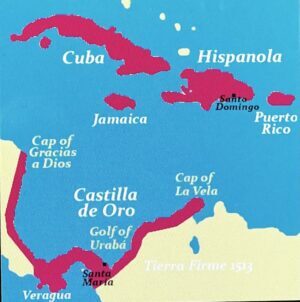
Ph.1 – Castilla de Oro, Tierra Firme 1513 @Santos30-wikipedia.com
___________________________
With him was Panquiaco the son of the Caquetá chief, who told him about a rich land that lay further south on the coast, with great kings. He told Balboa of seagoing boats, gold, and pearls; a land the natives called Birú, the name of its king. On September 25, 1513, Balboa stood on a thousand-foot-high peak in the Darien looking spellbound at the immensity of the South Sea, while his second in command, Francisco Pizarro gazed intently for in his mind echoed Panquiaco’s words…great lands…and…gold!..gold! This sketchy rumor laid the seeds of the Spanish conquest of Perú.
Conquistadors were granted a license to explore and conquer by the Spanish Crown in Madrid, stipulating that the venture would not carry any expense to the Crown. All costs were borne by the conquistadors, who had to borrow money and/or provide in-kind guarantees from families in Spain, as the cost of such ventures was high. Conquistadors had to pay for ships, crews, soldiers, weapons, and food; they had to build settlements to explore unknown and dangerous lands and fight endless battles in their ceaseless quest for gold. They had to pay for enlisted soldiers, ship crews, and debts. Many enlistees were paid soldiers released by the Spanish army from the Christian-Muslim War (1481-1492), or the Italian Wars (1494-1559).
An overseer from the Crown, appointed by the House of Trade of the Indies in Seville, was attached to each expedition, keeping detailed logs of goods and transactions. The conquistador paid him, and so he was a chaplain. The “Right of Conquest” was granted as a binding contract, which was predicated on the Crown’s receiving the royal fifth (quinto real) on all imported precious metals. Other taxes, which could run up to 40%, included providing naval protection for returning ships laden with treasure. Once the new territory was settled and pacified, the Crown appointed a vice-roy, governors, officials, and an army chief, while bishops of the Catholic orders assigned priests.
Born out of wedlock in Trujillo, Spain, in 1478, Francisco Pizarro joined the military in his late teens, rising to the rank of lieutenant while fighting in the Italian Wars, where he was wounded. Upon his return to Spain in 1502, Pizarro traveled to the Indies, as the recently discovered territories were known. When in Santo Domingo, on the island of Hispaniola, he was hired as a messenger in the local government. Frustrated in this position, he joined Captain General Alonso de Ojeda as a sub-officer.
With de Ojeda, he fought in the wars against the indigenous Taíno people on the island of Borinquen (today Puerto Rico), rising to second in command when de Ojeda, wounded by a poison-tipped arrow, had to return to Santo Domingo. Pizarro was instructed to wait forty days and, should de Ojeda not return, sail back to Santo Domingo with the soldiers. Pizarro followed de Ojeda’s instructions with a twist. He took two brigantines and sailed west with de Ojeda’s partner, Fernández de Enciso. They landed at the port of Santa Maria la Antigua del Darién (1510), in the estuary of the Tarena River on Panama’s Caribbean coast. There, he met Balboa, also called the “fellow of the drum” for his daring escape from creditors in Santo Domingo, hiding in a wine cask with his dog Leoncito. In Pizarro, Balboa recognized a kindred spirit and made him lieutenant governor.
_______________________________
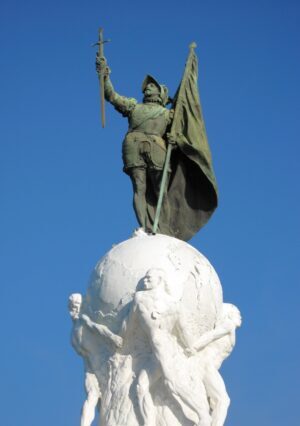
Ph.2 – Vasco Núñez de Balboa. @georgefery.com
_______________________________
In 1515, Balboa was named second to the governor of Castilla de Oro, Pedro Arias de Ávila (aka Pedrarias Dávila, 1440-1531), his father-in-law. For reasons that would deviate from our narrative, Balboa rebelled against Pedrarias who, after a speedy trial, had him beheaded in the town’s plaza, watching the proceedings hidden behind a curtain. In 1523, Pizarro took over Balboa’s position.
We have little knowledge of Pizarro, but his achievements point to his strong personality, ethical strength, and great determination to overcome hardship and fear. At that time, he was respected as one of the founders and the Mayor of Panama with a large cattle farm in the city’s outskirts. All these years, however, Pianquaco’s words about gold kept nibbling in his mind, so he set to work on a plan for the discovery down the coast of the South Seas. Once the plan was set, he brought in two partners, the military officer Diego de Almagro and the school master Hernando de Luque. The three swore secrecy and sealed the promise with a mass and sacraments in the main church of Panama. The partners agreed that their share of the riches would be split equally. Pizarro would captain the venture, Almagro would be his second in command, while Luque was tasked with defending the trio’s interests with the governor in Panama. The ink was not yet dry when the plan reached Pedrarias Dávila, who demanded to join the group as a silent partner, not to risk his position as governor of Tierra Firme. For his partnership, Pedrarias Dávila invested some money in the venture and provided the mandatory official license for the expedition, which is now called the “Eastern Enterprise” (Empresa del Levante).
On September 13, 1524, the two-masted ship Santiago departed with Francisco Pizarro in command and sailed west to Taboga in the Pearl Islands. His crew of adventurers comprised 112 ex-soldiers, misfits, and a few Nicarao Indians as support hands. Also aboard were a handful of horses and two war dogs. This first attempt did not go well. Beyond the Pearl Islands, the ship sailed south along the South American continent’s coast, fighting headwinds and gales. They stopped at fishing villages that showed no sign of wealth; the crew only found a few gold trinkets and semi-precious stones. They kept sailing south despite hardships and, at times, gnawing hunger. In February or April of 1525, before heading back to Panama, they stopped at what appeared to be the palisade of a fortified village up on a hill near the coast. The Spaniards called it Fortín del Cacique de Las Piedras. That afternoon, they went up through a thick jungle and found the place deserted, so they settled there for the night.
At dawn, war cries awoke the Spaniards who scrambled to face a large group of well-armed half-naked men. The battle was brutal, and the Spaniards fought their way back to the coast while the fearless war dogs saved the day by gutting natives. Fifty Spaniards were seriously wounded, and five were missing and presumed dead. Pizarro headed back to Chochama, his rear base in the Bay of Panama.
_____________________________

Ph.3 – First Forays @J.A. de Busto, 1973
_____________________________
Almagro and the San Cristóbal, another carrack mid-size ship, sailed a week after Pizarro with sixty-four soldiers, support personnel, horses, and war dogs. Like his partner, Almagro followed Pizarro’s southern route along the coast and tried with fifty men to capture Las Piedras, but he had to fall back fighting. Wounded in the face and losing an eye, he was about to be seized by the natives when Juan Roldán, a black free slave, saved him. The soldiers counterattacked and set fire to the stronghold, later called Battle of Punta Quemada. Fighting all the while, Spaniards moved back to the San Cristóbal with their wounded captain. They sailed to the Pearl Islands in the Gulf of Panama, and then to Chochama where Almagro joined Pizarro.
Both agreed that this first foray into the unknown did not produce much but sent the few pieces of gold they had found to Pedrarias Dávila in Panama City, who became furious upon learning of the poor returns on his investment. He called Pizarro an inept fool and other disrespectful names. He declared Birú a land of misery and threatened to fold the Eastern Enterprise and leave for Nicaragua to attend to Spanish settlers. Over the following days, Hernando de Luque informed Pedrarias Dávila about staying in the partnership, which he did with the condition that Pizarro be assigned second-in-command. Almagro welcomed this task to avoid the possibility of a fifth partner joining the venture.
_____________________________

Ph.4 – Pedro Arias de Ávila @silverreaderclub.com
_____________________________
The argument was settled and Pedrarias Dávila agreed to try another six-month voyage. Should that foray fail to produce results, however, the “Eastern Enterprise” would be terminated. On this second sailing, Luque grasped the opportunity to join Pizarro and Almagro. With good winds, in early February 1526, Pizarro and Almagro sailed again, each in command of one of the two manned and provisioned ships of the first voyage, together with three lighter support crafts. They were guided by the master pilot Bartolomé Ruiz de Estrada, who ran on the last route. Cruising south they stopped at Las Piedras and in anger killed every soul and burned the place again. On their way they anchored for water at Isla de las Palmas where in a brief skirmish with locals, two Spaniards were wounded. The men kept sailing south in heavy sea, and at the end of August 1526, along a river they would name San Juan, they assaulted villages to retrieve gold and silver artifacts. The country inland, however, was poor and hilly. Pizarro sent Almagro back to Panama with instructions to enlist more men, while the pilot Ruiz de Estrada was instructed to head south and explore the coast. At the same time, Pizarro and soldiers on horseback followed the ship’s track on land while exploring villages and coves. On his map, Estrada noted the mouth of several rivers with waters coming from the Andes Mountains seen far inland. For the first time, off the cape they called Cabo Pasado, they crossed the austral equinox line and, a couple of days later, off the island of Salango, they met five large outrigger boats with a sail and large paddle-rudders. Frightened by the foreigners, the crews jumped into the sea and swam to the coast. On one of the boats, however, the local trader and his crew of one man and three boys remained. They showed their loads of fine black and cream-colored ceramic bowls and plates and woven blankets of fine alpaca wool. These goods alluded to a cultured society.
The boats’ crew spoke a dialect used in a town the Spaniards would later learn was Tumbes, located further south on the coast. Pizarro took the boys and named them Felipillo, Yacané and Martinillo, for their actual names could not be translated, and ordered the ship chaplain to teach them Spanish. Pizarro wanted to continue further down the coast, but his crew rebelled because, after months at sea, they wanted to return home; anger almost led to blows.
When Almagro returned from Panama with more men, horses, and food, he brought news that Pedrarias Dávila had been replaced as governor of Tierra Firme by Pedro de los Ríos. Pizarro kept sailing south, and toward the end of July 1527, came to a river named Santiago. The most lucrative encounter occurred close to Isla de Salango’s Punta Illote, a spot they will later call Cabo de la Vuelta, marking the point where they headed back north to answer the crew’s pressing demands to return home. Tired of their complaints, Pizarro ordered the captain to head north to a forested hilly island they called Isla de Gallo. He claimed that the ship’s hull needed cleaning, so the ship had to be beached. Once the work was done, the crew believed they would be returning home. Then in mid-September two white sails appeared on the horizon.
Pizarro thought that more people and support were coming. Instead, captains Juan Tafur and Pedro de los Ríos landed on the beach with the service boat with orders from Panama’s governor for everyone to return. Tafur sternly demanded that Pizarro and Almagro promptly sail back with all their men. After a tense and bitter exchange, the men came close to settling the argument with their swords. As recorded by eyewitnesses, Pizarro then traced a line in the sand and said: “On this side are those who want to return to Panama and be poor; on my side, those who will remain with me and be rich; your call!” Thirteen crossed over the line, as did the pilot Ruíz de Estrada, even though he had pleaded earlier with Pizarro to return for family reasons. After six months having been left stranded by Tafur, who had returned to Panama with the remaining crew, fighting hunger, torrential rains, mosquitoes, and fever, in March 1528, another sail on the horizon signaled the arrival of a ship from the north, with instructions from the Panama governor to return to Panama. Pizarro again refused, and the partners convinced Ruìz to keep sailing south against the winds and storms of the season. After two weeks, they landed on an island they called Isla de Santa Clara, where they found offerings of finely painted ceramics, fine embroidered textiles, and many large gold and silver disks at the feet of a large stone idol.
The following day, five ocean-going native outrigger boats appeared. They were from the same community as those they had met the year before. They were tumbesinos warriors who led them a few miles south, to a large town called Tumbes, which was protected by a stone wall and a fortress built of massive quadrangular stones. The town’s chief Chilimaza sent men to greet the foreigners. The envoys were kurakas, Quechua-speaking magistrates assigned to large towns by the Great Inca in Cusco. As a welcome, the tumbesinos offered them food, water, and three llamas, which the Spaniards thought were camels without humps. Pizarro was invited to visit the city, but wary of treachery, sent the Greek Pedro de Candia, two musketeers, a mounted horseman, a war dog, and gifts of animals then unknown in Perú: two live pigs, five chickens, and a rooster. Reports from the visit were that the city was well built of stone and its streets clean and paved. Buildings and temples, such as a monastery for the virgins dedicated to the Sun, were likewise well built with carefully shaped stones. People were finely dressed in leather sandals, while markets were well provided with all types of fruits and vegetables.
Pizarro left Tumbes without getting into the town, with thanks and the promise of return (which he did in 1532 on his third expedition, when he battled and defeated chief Chilimaza). The Spaniards kept sailing south and found an island they called Isla de los Lobos on the Paita coast, eventually landing in a cove they named Malabrigo. There, they learned that one of the crew, Bocanegra, had deserted and remained with the Indians. On May 3, 1528, the ship headed back to Panama.
Pizarro’s arrival was the most significant event since the city’s foundation. Everybody gathered at the port to see the gold and silver, the colorful fabrics, the ceramics, and the horse-like animals (llamas). The crew members who had returned with Tafur bitterly deplored their lack of resolve. The name Perú, instead of Birú, was officially recognized and spread from mouth to mouth and from streets to taverns. The “Eastern Enterprise” was renamed the “Perú Enterprise.” Not so happy was Governor Pedro de los Rìos, for he was concerned that should many people leave for the new land, it would depopulate the government of Tierra Firme.
The partners realized they needed their discovery to be recognized by the Crown in Madrid. After arguing about the terms of a potential contract, they agreed that Pizarro should go to Spain, where he would ask for titles for each of them: governor of Perú, for Pizarro; “adelantado” or military commander, for Almagro; and the bishopric of Tumbes for Luque. Ruiz de Estrada would get the title of “alguacil mayor,” an ancient title meaning bailiff and a high office charge. The thirteen crew members of the last expedition would receive bonuses in addition to paid functions.
In early September 1528, when all was agreed, Pizarro boarded a ship from the port of Nombre de Dios on Tierra Firme’s Caribbean coast. With him were the young boys Felipillo, Yacané and Martinillo whom he had captured off the Island of Salango; the ship also carried half a dozen llamas, fine painted ceramics and embroideries, and much gold and silver. Pizarro landed at the Spanish port of Sanlúcar and went on to Seville. There, the lawyer Martin Fernández de Enciso recognized Pizarro as Alonso de Ojeda’s former lieutenant, accused him of having connived with Pedrarias Dávila in Balboa’s trial and execution, and demanded that he be jailed.
Someone at Court in Madrid, probably Pizarro’s brother Hernán demanded, through the Council’s office, that he be released on grounds of unsustainable facts and falsehood. In Madrid, Pizarro met with members of the Royal Supreme Council of the Indies, where he presented his written accounts and the maps of his voyages of discovery to Queen Isabela.I (1451-1504). He presented the tumbesinos Felipillo, Yacané, Martinillo and showed the llamas, the finely embroidered fabrics, and the gold and silver. The Royal Council was stunned by the news of this unknown world, which they named Nueva Castilla. A formal agreement was created, granting Pizarro the titles of Captain General, Governor, Administrator, and Constable over New Castille’s 200 leagues (700 miles). This area would henceforth be called Perú. Pizarro would receive an annual remittance of 725,000 gold maravedis (+/-$240K); Almagro was named Mayor and Constable of Tumbes, renamed Nueva Valencia de la Mar del Sur, with 300,000 maravedis and the honorific title of “hidalgo” or gentleman; Bartolomé Ruiz was named first navigator of the South Seas with 60,000 maravedis; Pedro de Candia was elevated to the rank of artillery major of Perú and councilor of Tumbes, while the thirteen sailors were granted the status of knights of the Golden Spur with related benefits.
___________________________
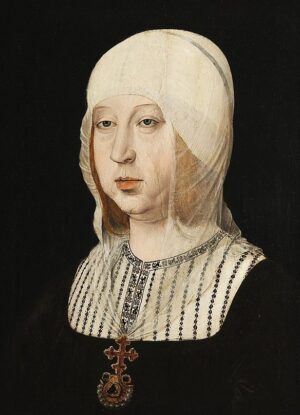
Ph.5 – Queen Isabela.I of Castille @wikipedia.com
___________________________
Under the terms of the agreement, Pizarro was authorized to set up towns with good soil and clear running water to grow food; name town mayors; mine gold and silver; build forts and organize military forces of 250 men; import horses and slaves; protect and evangelize the natives. Queen Isabela.I signed this Capitulación de Toledo or Agreement of Toledo, on 6 of July 1529. Once the nominations and agreement were signed, Pizarro, now with the title of governor of Perú rode to Trujillo, his birthplace in the province of Extremadura. He enjoyed his extended family there for a few weeks, many of whom would follow him to the New World. They included his illegitimate brothers Juan and Gonzalo Pizarro, a half-brother, Francisco Martín de Alcántara, and several childhood friends. In early 1530, they all met in Seville with Crown officials assigned to follow Pizarro, who planned to sail from the port of Sanlúcar de Barameda, instead of the traditional port of Cádiz. His last-minute port change was to bypass the terms of his agreement and exit license, which required him to take 250 soldiers.
Pizarro’s brother Hernando smartly suggested that, with his family and friends, the number of men met the exit license requirements. Meanwhile, the partners in Panama, Almagro and Luque, anxiously awaited Pizarro’s arrival in Nombre de Dios. Almagro was angry because, in past correspondences, he believed that his partner had hoarded Perú’s three most important Crown titles. He was enraged that he wanted to break the “Perú Enterprise.” Luque told him that there had to be reasons that would be explained upon their partner’s arrival. Almagro tepidly welcomed Pizarro, who, perceiving his partner’s antagonism, told him that he had to accept the three titles because the Crown did not want to split the agreement between two or more holders. Therefore, he had to bow to the Crown’s demands or lose the deal. Pizarro then underlined that the “Perú Enterprise” terms of association of equal partnership remained unchanged. Almagro was mollified, and the partners started to organize the third expedition to Perú. As expected, arguments quickly arose between Almagro and Pizarro’s brothers, Juan, González, and Hernando, with whom Almagro never got along. The antagonism was again threatening to break the enterprise, but thanks to Pizarro’s authority and Luque’s conciliatory approach, Almagro remained.
In the following weeks, two ships arrived from Nicaragua loaded with Indian slaves, under the command of Juan Ponce de Leon and his partner Captain Hernando de Soto. For his support in the Perú venture, de Soto demanded the position of lieutenant governor. He further demanded, for Ponce de León discoverer of Florida (1513), a large portion of land with natives to conquer. Once Pizarro, Almagro, Luque and the others agreed on the terms of their association, they prepared the third expedition.
On December 27, 1530, the flags were blessed in Panama’s main church. The following day, Pizarro called for sailing within the next few weeks, and on January 20, 1531, they sailed to the Pearl Islands and then headed south with a good sea and winds. Besides its crew, there were 180 soldiers, support personnel, 36 horses, and war dogs. The second ship under Captain Cristóbal de Mena’s command was ordered to follow in early February.
Pizarro and his army landed on February 17 in a bay called San Mateo. While the second ship sailed further south, Pizarro, on horseback, accompanied by riders, headed inland along the coast. They entered the town of Atacames, where locals wore fine dresses. In the fishing town of Cancebi they met nobles wearing jewels of gold and saw precious ceramics and fishing nets. Tired, hungry, and under clouds of mosquitoes, they crossed the Quiximes Delta and, battling Coaque natives, found more gold and emeralds. Still heading south, and suffering from painful warts that crippled many, they stopped at a small village where they stayed from April 19 to September 11 to recover. In mid-September, a boat from Nicaragua arrived with reinforcements. The captain, Sebastián de Belalcázar, agreed to bring his men to join Pizarro’s troops, together with two of his friends, on condition that one be named aide-de-camp to Pizarro and the other the town’s mayor. With his sick army, Pizarro had no choice but to agree to the demands. With reinforcement, he proceeded south on a desert-like landscape of vast arid and sandy coastal plains interspaced by valleys and rivers of low water flow, seasonally fed by the snow melts from the snow melts of the Andes mountains.
In early October, after passing through Anta, Odon, and other small towns, and a place named Punta de Santa Elena, Pizarro rested his tired, thirsty, and hungry troopers. On Christmas Day of 1531, they met the Puna Island’s chief, Tumbalá, who brought them water and food, and invited them to visit his island. From past experiences of natives’ tricks hidden by smiles, Pizarro insisted he would only board the boat with the local chief, who was taken aback but accepted.
_________________________
At this point, it is suitable to clarify who the people of Perú were in the sixteenth century. Today, the country is home to fifty-eight indigenous groups speaking forty-seven languages. The largest is Quechua, with Aymara being a second, but essential, group, which together make up about a quarter of the country’s indigenous population. When the Spaniards arrived in the sixteenth century, there were more ethnic groups, each with their dialect, beliefs, customs, and antagonisms. Quechua was spoken in the kingdom’s capital, Cusco, called “Land of Four Parts” or Tahuantinsuyo. It spanned a territory from today’s Ecuador to most of the northern part of Chile and the northwestern part of Argentina in the south. This mosaic of cultures and languages strained under the Incas’ iron-fisted authority, which fueled sporadic rebellions.
Pizarro understood the latent antagonisms but did not realize then the immensity, complexity, and cultural fragmentation of the Inca empire. His persistent distrust of unknown people was grounded in his experiences in sixteenth-century European wars, where defiance was the norm. On Puna Island, captive young men from other tribes confirmed his suspicions. Pizarro learned about an agreement between recent enemies, Tumbalá of Puna and Chilimaza of Tumbes. The latter had secretly arrived at night with warriors to capture or kill the white-bearded men, who fought back savagely for their lives. The Spaniards were saved by the arrival of two ships and soldiers under the command of Hernando de Soto, who turned the tide.
___________________________

Ph.6 – Francisco Pizarro @wikipedia.com
___________________________
The “war of succession” that had gone on in the mountains over the last few years indirectly affected the people of the coast, but they knew what was happening from families and friends. Inca officials seconded the chiefs of towns and cities to assist them in administering and overseeing the local political order. That is why it was found later that the Inca governor of Tumbes knew about Tumbalá and Chilimaza’s deep-seated antagonism. Under threat from the Inca, they were forced to cooperate and capture or kill the Europeans, who were unaware of the raging war in the country. In April 1532, with de Soto in Chilimaza’s light boats, the Spaniards boarded their ship and left the island, which they had renamed Isla de Santiago. They then sailed to Tumbes on the coast and left that city on May 16 of that year, leaving behind a squadron of soldiers, a Crown official and a priest. A week later, Pizarro and his men reached the town of Poechos, where its chief Maizavilca welcomed them. Over a few weeks, Pizarro informed him of his plan to build a city and a port on the coast a few leagues away at the mouth of the Río Chíra. This plan alienated the chief’s welcome because he realized that he would lose authority. Like other chiefdoms in the region, however, he wanted to shake off the heavy hand of the Sapa Inca in his affairs but realized that he might have welcomed a heavier hand that would weaken his kinglet powers. Maizavilca shared his concerns with other principals of townships in the Río Chira’s Valley, who agreed to persuade Pizarro to move up the mountains, where bigger prizes and gold awaited. The Indian chiefs’ double aim was to get the Spaniards out of their lands and hand them over to Inca Atahualpa’s army, encamped near Cajamarca, nine thousand feet up in the Andes Mountain range.
The Inca was informed of the progress of Pizarro’s army on the coast and sent a spy to ascertain that they were men and not, as Maizavilaca claimed, huiracochas, the messengers of Huiracocha, the foremost god in the Inca religious pantheon. The spy met Hernando Pizarro and understood he was Francisco Pizarro’s brother. He was fascinated by the barber who shaved men’s faces, and the tamer who, at will, managed horses and war dogs. He also found out that horses only ate grass, not meat, while war dogs ate meat, not grass. His most significant discovery was that the Spaniards were men, not huiracochas, and he reported his findings to the Inca Atahualpa, who understood Maizavilca’s duplicity and kept it in mind for later retribution.
______________________________

Ph.7 – Hernando de Soto @wikipedia.com
______________________________
Pizarro was still focused on building a town to settle European migrants. So, on July 15, 1532, he built the village of Tangarará on a promontory South of Poechos in the delta of Rio Chira, whose shores were covered with trees and grass. It will not be his last attempt at a permanent settlement. Pizarro’s thirst for gold had not dimmed despite his venture’s trials, hardships, and growing costs. At that time, he knew the riches were not on the coast but up the mountains in Cusco, where he said the city was covered with gold.
Persistent rumors by natives about war up in the mountains would not stop him. He promised the rope to warn would-be deserters in his crew, demanding to return to Tierra Firme. Unbeknownst to the Spaniards, over the last two years, the war of succession for the crown of the Tahuantinsuyo or “Land of Four Parts” had raged between Huayna Capac Inca Yupanqui’s two sons, Atahualpa and Huascar. This tragic chapter of Perú’s history will be narrated in the next installment, “The Fall of Cusco.”
_______________________________
Cover Image, Top Left: Pizarro and the Inca of Peru, Public Domain, Wikimedia Commons
Bülent Ortakcı is a freelance and ghostwriter based in Turkey. As an independent writer with a deep passion for history and archaeology, he focuses on creating compelling articles rooted in thorough research and inspired by the rich heritage of Anatolia and surrounding regions.
His writings often explore lesser-known archaeological sites, the legacy of ancient civilizations, comparative religious beliefs, and folklore involving supernatural or paranormal phenomena.

Hierapolis, the ancient city perched above the gleaming white travertine terraces of Pamukkale, is far more than a visual marvel. Beneath its shining façade lies a city of deep myth, sacred rituals, and mysterious structures that have captivated archaeologists and historians alike. Among its most enigmatic discoveries stands the so-called Pluto’s Gate, or as the ancients called it, the Ploutonion — a doorway not merely of stone and myth, but of fear and reverence.
Pluto’s Gate Through Ancient Eyes
The Ploutonion was no ordinary location. Ancient sources speak of it with a tone of both awe and dread. The geographer Strabo (64 BCE – 24 CE) describes how any animal brought near the gate would perish almost instantly, recounting how he threw sparrows into the space and watched them collapse, lifeless, in seconds. The Roman historian Cassius Dio similarly acknowledged its deadly properties, reinforcing the belief that this cave concealed a force beyond human comprehension.
The Ploutonion was dedicated to Pluto (Hades), the god of the underworld, and his consort Persephone. According to ancient beliefs, the toxic gas that emanated from the cave was seen as Pluto’s breath — a divine yet lethal exhalation from the world below. Strangely, members of the Galli, eunuch priests of the Cybele cult, were said to enter the cave unharmed. This gave rise to the belief that they either possessed supernatural protection or shared a sacred bond with the gods of the underworld. During ritual ceremonies, they performed sacrificial rites, offered prayers, and may have delivered oracular prophecies. A popular ritual involved selling small animals to visiting pilgrims. These animals would be released into the cave to demonstrate the fatal power of the gas — a dramatic proof of the gods’ presence and wrath.
The Rediscovery of a Deadly Sanctuary
For centuries, the precise location of Pluto’s Gate remained a mystery. That changed in 2013, when a team led by Italian archaeologist Francesco D’Andria uncovered the site during excavations near the Temple of Apollo. Their findings bore an uncanny resemblance to ancient descriptions, confirming the Ploutonion’s authenticity. Among the uncovered structures were the foundations of the sacred temple, remnants of a small theater believed to be used for observing rituals, and inscriptions dedicated to Pluto and Kore (Persephone). Most strikingly, the entrance to the cave — from which the lethal vapors once emerged — was found just as Strabo described.
____________________________

Hierapolis. Pexels
____________________________

Hierapolis. Pixabay
____________________________

Pamukkale. Pixabay
____________________________

Pluto’s Gate, a sacred cave believed to be an entrance to the underworld and the oldest local sanctuary, Hierapolis. It was described by Strabo (629-30) as an orifice in a ridge of the hillside, in front of which was a fenced enclosure filled with thick mist immediately fatal to any who entered except the eunuchs of Kybele. The Plutoneion was mentioned and described later by numerous ancient writers, in particular Dio Cassius (68.27), who observed that an auditorium had been erected around it, and Damascius ap. Photius (Bibl. 344f), who recorded a visit by a certain doctor Asclepiodotus about A.D. 500; he mentioned the hot stream inside the cavern and located it under the Temple of Apollo. There is, in fact, immediately below the sidewall of the temple in a shelf of the hillside, a roofed chamber 3 m square, at the back of which is a deep cleft in the rock filled with a fast-flowing stream of hot water heavily charged with a sharp-smelling gas. In front is a paved court, from which the gas emerges in several places through cracks in the floor. The mist mentioned by Strabo is not observable now. The gas was kept out of the temple itself by allowing it to escape through gaps left between the blocks of the sidewalls. Carole Raddato, Image and text CC BY-SA 2.0, Wikimedia Commons
____________________________
Science Meets Myth: The Deadly Gas Explained
What was once seen as divine wrath has since found a rational explanation. Scientific analysis revealed that the cave emits high concentrations of carbon dioxide, a gas heavier than air that settles near the ground. Animals — smaller and closer to the earth — were the first to succumb, while humans standing upright, especially trained priests who understood when the gas levels were lower, could avoid its effects. This phenomenon, viewed in antiquity as a divine miracle, is today understood as a natural, though no less fascinating, geological feature.
The Rise and Fall of a Sacred Site
Archaeological records show that the Ploutonion remained an active place of worship and pilgrimage until the 4th century CE. With the rise of Christianity, such pagan sanctuaries lost their religious significance. By the 6th century, a series of devastating earthquakes buried the site, shrouding it in silence for over a millennium.
Sacred, Lethal, Eternal
The Ploutonion of Hierapolis represents a unique fusion of mythology, natural science, and ancient religious practice. It is a place where faith and fear, death and divinity, coexisted. In today’s world, it continues to draw the curiosity of scholars, spiritual seekers, and tourists alike — not only for its deadly beauty but for what it tells us about how ancient people interpreted and interacted with the invisible forces of the earth. Now partially restored and protected, Pluto’s Gate stands once more — not as a passage to the underworld, but as a window into humanity’s eternal attempt to make sense of life, death, and the divine.
Bülent Ortakcı is a freelance and ghostwriter based in Turkey. As an independent writer with a deep passion for history and archaeology, he focuses on creating compelling articles rooted in thorough research and inspired by the rich heritage of Anatolia and surrounding regions.
His writings often explore lesser-known archaeological sites, the legacy of ancient civilizations, comparative religious beliefs, and folklore involving supernatural or paranormal phenomena.
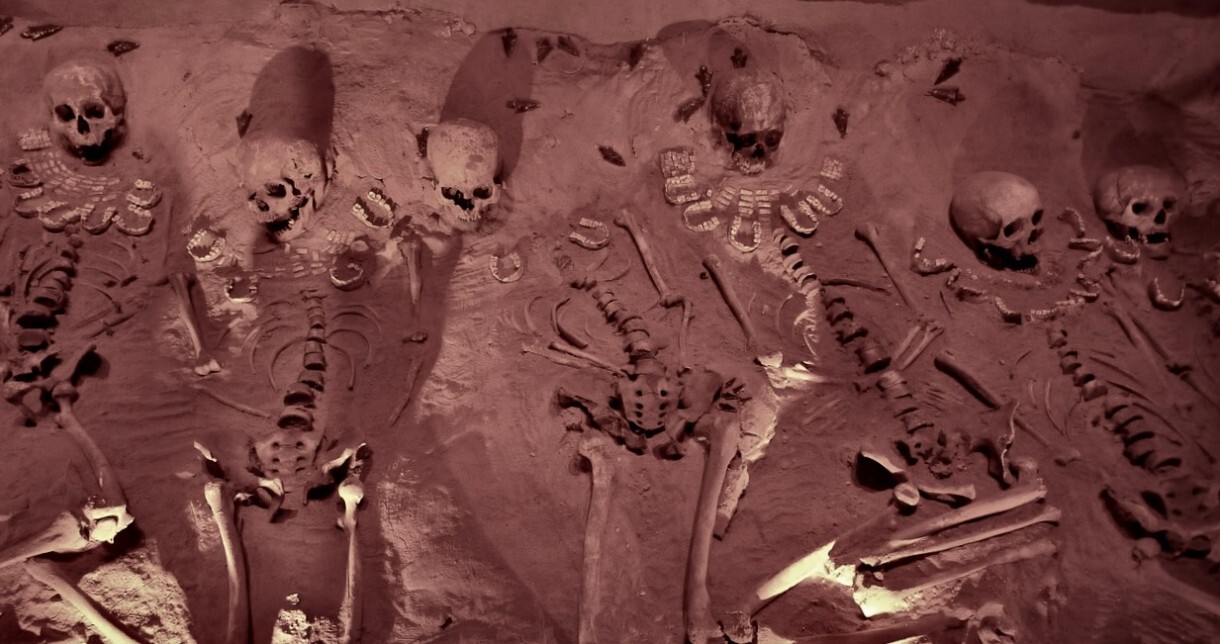
In the remote soils of southeastern Anatolia, where time itself seems to have settled into layers of dust and silence, a discovery emerged in 2024 that spoke not in words, but through bone, ornament, and gesture. At Boncuklu Tarla—a Neolithic settlement nestled within the rugged contours of Mardin’s Dargeçit district—archaeologists uncovered objects so ancient, yet so intimate, they might as well have whispered directly from the mouths of the dead. What they found were no ordinary artifacts. These were personal adornments— piercings for lips and ears—crafted from stone, obsidian, marble, and even native copper. They had once adorned human bodies more than eleven millennia ago. And in that adornment, they told stories—of identity, transition, ritual, and belonging.
A Civilization Written on the Body
Boncuklu Tarla, continuously inhabited between approximately 10,300 and 7,100 BCE, has already garnered archaeological fame for its architectural remnants and vast array of ornamental objects. Over 100,000 beads, pendants, and decorations have been unearthed at the site since 2012. But the recent discovery of labret and earring-like ornaments in adult burials adds a new and compelling chapter to this unfolding narrative. These items were not placed arbitrarily. Many were discovered near the mandible and temporal bones, precisely where piercings would have been worn. More revealing still, subtle wear patterns on the lower front teeth suggest prolonged and habitual use of lip ornaments—a bodily tradition encoded not just in stone, but in enamel and flesh.
Ornamentation as Ontology
Unlike the decorative excesses of modern fashion, the piercings of Boncuklu Tarla appear to have carried profound symbolic weight. Their absence from child burials and exclusive presence in adults hints at a rite of passage—an embodied transformation from innocence to responsibility, from anonymity to social presence. Here, the human body was not merely a biological entity but a sacred canvas, inscribed with meaning through ritual and ornament. Piercing may have served not just aesthetic desires, but cosmological beliefs, binding the self to community, the living to the ancestral, and the visible to the invisible.
Between Silence and Symbol
In a world without written language, where meaning circulated through gesture, stone, and rhythm, the body became the text. These adornments spoke—of gender, status, age, perhaps even spiritual authority. They were marks of being seen and remembered. They were declarations etched into skin and soul. Through them, we glimpse a civilization both distant and familiar: one in which humans, long before cities or empires, yearned to signify who they were and what they believed—by marking the very skin that carried them through life and into death.
Conclusion
The pierced ornaments of Boncuklu Tarla do more than extend the timeline of human adornment. They reshape our understanding of early Neolithic thought, aesthetics, and social structure. They remind us that identity is an ancient yearning, and that even in the earliest settlements of humanity, the body was already a vessel of expression, ritual, and meaning.
__________________________
Cover Image, Top Left: aitoff, Pixabay

American Association for the Advancement of Science (AAAS)—Genomic insights into Greenland’s iconic sled dog reveal a rich history of Inuit migration and Arctic adaptation, according to a new study. The findings provide a crucial guide for preserving the ancient breed amid climate threats and rapid cultural change. For over 9,500 years, sled dogs have been a central part of Arctic life. While many Arctic sled dog breeds have been replaced, mixed with other dogs, or shifted into domestic roles, the Greenland sled dog, or Qimmeq (pl. Qimmit), has uniquely preserved its traditional role as a working sled dog. However, this ancient working relationship now faces modern threats: climate change, urbanization, and modern technologies like snowmobiles are rapidly eroding the conditions that have long supported Qimmit and their traditional role. The ongoing decline in Qimmeq population underscores the urgency of documenting their remaining genetic diversity to guide conservation efforts. To reconstruct the breed’s history, Tatiana Feuerborn and colleagues sequenced genomes from 92 dogs across Greenland spanning the past 800 years, capturing both ancient and modern individuals, and compared them with over 1,900 published dog genomes. Feuerborn et al. discovered that Qimmit form a distinct clade with other ancient Arctic dogs – most notably a 3,700-year-old Alaskan dog. This genetic continuity, despite thousands of years and great geographic distances, supports the theory of a rapid Inuit migration across the North American Arctic. Notably, the authors found that the genetic differentiation among regional dog populations mirrors the cultural and linguistic divisions of the indigenous peoples of Greenland. Moreover, the analysis revealed further evidence of two distinct migrations of dogs into Greenland, with data that indicate an earlier-than-expected arrival of people to the region. Feuerborn et al. also show that despite European colonization of Greenland, there is minimal European ancestry in present-day Qimmit, likely due to overall isolation of the populations and more modern preservation policies. “These insights into the Qimmit provide a baseline for levels of inbreeding and introgression that can serve as a foundation for informed management aimed at the preservation of these remarkable dogs,” write the authors. “Studies such as this demonstrate the relevance of paleogenomic insight into current conversations and decisions centered around conservation and preservation of culturally significant species.”
____________________________
Article Source: AAAS news release
*Origins and diversity of Greenland’s Qimmit revealed with genomes of ancient and modern sled dogs, Science, 10-Jul-2025.
Cover Image, Top Left: Husky sled dogs. cocoparisienne, Pixabay

University of Houston—Archaeologists from the University of Houston working at Caracol in Belize, Central America have uncovered the tomb of Te K’ab Chaak, the first ruler of this ancient Maya city and the founder of its royal dynasty. Now in ruins, this metropolis was a major political player in Maya history, dominating the southern part of the Yucatan Peninsula from 560 through 680 AD before its abandonment by 900 AD.
The discovery is the first identifiable ruler’s tomb found in over four decades of work in Caracol, the largest Maya archaeological site in Belize and in the Maya lowlands.
Te K’ab Chaak, who acceded to the throne in 331 AD, was interred at the base of a royal family shrine with eleven pottery vessels, carved bone tubes, jadeite jewelry, a mosaic jadeite mask, Pacific spondylus shells, and other perishable materials. Pottery vessels in the chamber included a scene of a Maya ruler holding a spear and receiving offerings from supplicants in the form of deities. Another vessel portrays the image of Ek Chuah, Maya god of traders, surrounded by offerings. Four of the pottery vessels portray bound captives (similar vessels also appeared in two related burials). Two vessels supported lids with modeled handles of coatimundi (pisote) heads. The coatimundi, or tz’uutz’ in Maya, was used by subsequent Caracol rulers as part of their names.
A team led by husband and wife collaborators Arlen F. Chase and Diane Z. Chase of the University of Houston has been excavating at Caracol for more than 40 years; this field season was carried out in concert with Belize’s Institute of Archaeology and was supported by the Alphawood Foundation, the University of Houston, the Geraldine and Emory Ford Foundation, and the KHR Family Fund.
The Chases estimate that at the time of his burial the ruler was of advanced age and approximately 5’7” in height. He had no remaining teeth.
Their investigations at Caracol’s Northeast Acropolis show that Te K’ab Chaak’s tomb was the first of three major burials dating to about 350 AD, a time of early contact with the central Mexican city of Teotihuacan, some 1200 kilometers distant. By 300 AD, Teotihuacan was a huge city that traded throughout Central America.
“One question that has perplexed Maya archaeologists since the 1960s is whether a new political order was introduced to the Maya area by Mexicans from Teotihuacan,” said Diane Z. Chase, archeologist and senior vice president for academic affairs and Provost at the University of Houston. “Maya carved stone monuments, hieroglyphic dates, iconography, and archaeological data all suggest that widespread pan-Mesoamerican connections occurred after an event in 378 AD referred to as the “entrada.” Whether this event represented actual Teotihuacanos in the Maya area or Maya using central Mexican symbols is still debated. The Caracol archaeological data suggests that the situation was far more complicated.”
A cremation placed in the center of Caracol’s Northeast Acropolis plaza, recovered in 2010 and placed after Te K’aab Chaak’s burial has been dated to AD 350 by radiocarbon analysis and included artifacts from central Mexico. It contained the remains of three individuals, as well as two large knives, six atlatl points, and fifteen pristine blades of green obsidian from Pachuca, Mexico (north of Teotihuacan); several pottery vessels also likely came from central Mexico. Additionally, a carved atlatl projectile tip, atypical for the Maya but typical for a Teotihuacan warrior, was included in the cremation.
The cremation itself and its placement in the center of a residential plaza are also more typical practices for a high-status Teotihuacano and do not accord with standard Maya burial practices. Based on other ceramics in this cremation, the main individual was likely a Caracol royal family member that had adopted central Mexican ritual practices. This individual may even have served as a royal Maya envoy who had lived at Teotihuacan and returned to Caracol.
A third burial – the tomb of a woman, also covered with hematite and containing four pottery vessels, a spondylus bead necklace, mirror fragments, and two Pacific spondylus shells – was recovered in the northern building of the same residential group in 2009 and is similarly dated.
The three burials interred in the Caracol Northeast Acropolis all cluster at AD 350, at least a generation before the previously recognized Teotihuacan presence in the Maya area. They demonstrate that early Maya rulers were fully enmeshed in Mesoamerican-wide contacts prior to the Teotihuacan entrada recorded on Maya monument[s].
“Both central Mexico and the Maya area were clearly aware of each other’s ritual practices, as reflected in the Caracol cremation, said Arlen F. Chase, professor and chair of Comparative Cultural Studies at the University of Houston. “The connections between the two regions were undertaken by the highest levels of society, suggesting that initial kings at various Maya cities – such as Te K’ab Chaak at Caracol – were engaged in formal diplomatic relationships with Teotihuacan.” The royal dynasty established by Te K’ab Chaak continued at Caracol for over 460 years.
The Chase’s findings also indicate that ancient peoples in the new world were travelers. A trip between Teotihuacan and Caracol today by car would take over 23 hours. The one-way walking time may be estimated to be approximately 153 days.
Research continues on the contents of the chamber with the reconstruction of the jadeite death mask and with ancient DNA and stable isotope analysis of the skeletal material. The Chases will present results of the 2025 Caracol field season at a conference on Maya–Teotihuacan interaction hosted by the Maya Working Group at the Santa Fe Institute (New Mexico) in August 2025.
_____________________________

University of Houston provost and archeologist Diane Chase in newly discovered tomb of the first ruler of the ancient Maya city Caracol and the founder of its royal dynasty.
Caracol Archeological Project/University of Houston
_____________________________
Article Source: University of Houston news release
_____________________________
About the Chases
Married since 1975, Diane and Arlen Chase are two of the most influential Maya archaeologists in the world, and the foremost experts on Caracol, one of the most significant ancient Maya cities.
Since their first dig in 1985, the Chases have become known for:
The Chases will present detailed information on the tomb and other finds from Caracol at the Santa Fe Institute in August.
______________________________
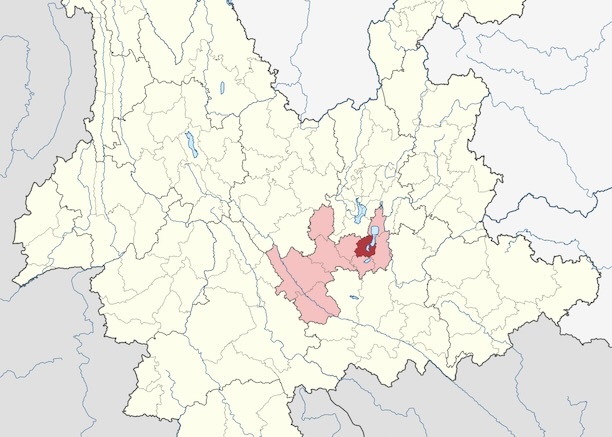
American Association for the Advancement of Science (AAAS)—New discoveries from the Pleistocene-age Gantangqing site in southwestern China reveal a diverse collection of wooden tools dated from ~361,000 to 250,000 years ago, marking the earliest known evidence of complex wooden tool technology in East Asia. The findings* reveal that the Middle Pleistocene humans who used these tools crafted the wooden implements not for hunting, but for digging and processing plants. Although early humans have worked with wood for over a million years, wooden artifacts are quite rare in the archaeological record, particularly during the Early and Middle Pleistocene. Most ancient wooden tools have been found in Africa and western Eurasia, with notable examples that include spears and throwing sticks from Germany and the UK, dating back 300,000 to 400,000 years, as well as structural elements like interlocking logs from Zambia and wooden planks and digging sticks from sites in Israel and Italy. While the long-standing Bamboo Hypothesis argues that early East Asian populations relied on bamboo for toolmaking, archaeological evidence for organic material-based tools from the region is scarce.
Here, Jian-Hui Liu and colleagues present new findings from the Gantangqing site in southwestern China, which has yielded a wide range of artifacts. Among these are 35 wooden artifacts that exhibit clear evidence of intentional shaping and use, including signs of carving, smoothing, and wear, suggesting that they were purposefully crafted by hominins. These tools, most of which were fashioned from pine, range from large two-handed digging sticks to smaller hand-held implements, and even include hook-like tools potentially used for cutting plant roots. According to Liu et al., compared to other well-known contemporaneous wooden tool sites in Europe, which are generally characterized by medium-sized hunting gear, Gantangqing stands out for its broader and more diverse array of small, hand-held tools designed primarily for digging up and processing plants. The sophistication of these wooden tools underscores the importance of organic artifacts in interpreting early human behavior, particularly in regions where stone tools alone suggest a more “primitive” technological landscape, say the authors.
___________________________________
Article Source: AAAS news release
*300,000-year-old wooden tools from Gantangqing, southwest China, Science, 3-Jul-2025. www.science.org/doi/10.1126/science.adr8540
Cover Image, Top Left: Map showing location of Jiangchuan (red) and Yuxi Prefecture (pink) within Yunnan province of China. 瑞丽江的河水, CC BY-SA 4.0, Wikimedia Commons

Forty years after Nobel Prize winner Svante Pääbo’s pioneering attempts to extract ancient DNA from individuals from ancient Egypt, improvements in technology have now paved the way for the breakthrough today, which is also the first whole genome (the entire set of DNA in an individual) from ancient Egypt.2
During this period of ancient Egyptian history, archaeological evidence has suggested trade and cultural connections existed with the Fertile Crescent – an area of West Asia encompassing modern-day Iraq, Iran and Jordan, among other countries.
Researchers believed that objects and imagery, like writing systems or pottery, were exchanged, but genetic evidence has been limited due to warm temperatures preventing DNA preservation.
In this study, the research team extracted DNA from the tooth of an individual buried in Nuwayrat, a village 265km south of Cairo, using this to sequence his genome.
The burial had been donated by the Egyptian Antiquities Service, while under British rule, to the excavation committee set up by John Garstang. It was initially housed at the Liverpool Institute of Archaeology (which later became part of the University of Liverpool) and then transferred to World Museum Liverpool.3
The individual died at some point in the overlap between two periods in Egyptian history, the Early Dynastic and Old Kingdom periods, and had been buried in a ceramic pot in a tomb cut into the hillside. His burial took place before artificial mummification was standard practice, which may have helped to preserve his DNA.
By analysing his genetic code, the researchers showed that most of his ancestry mapped to ancient individuals who lived in North Africa. The remaining 20% of his ancestry could be traced to ancient individuals who lived in the Fertile Crescent, particularly an area called Mesopotamia (roughly modern-day Iraq).
This finding is genetic evidence that people moved into Egypt and mixed with local populations at this time, which was previously only visible in archaeological artefacts. However, the researchers caution that many more individual genome sequences would be needed to fully understand variation in ancestry in Egypt at the time.
By investigating chemical signals in his teeth relating to diet and environment, the researchers showed that the individual had likely grown up in Egypt.
They then used evidence from his skeleton to estimate sex, age, height, and information on ancestry and lifestyle. These signs suggested he could have worked as a potter or in a trade requiring comparable movements, as his bones had muscle markings from sitting for long periods with outstretched limbs.4
Adeline Morez Jacobs, Visiting Research Fellow and former PhD student at Liverpool John Moores University, former postdoctoral researcher at the Crick and first author, said: “Piecing together all the clues from this individual’s DNA, bones and teeth have allowed us to build a comprehensive picture. We hope that future DNA samples from ancient Egypt can expand on when precisely this movement from West Asia started.”
Linus Girdland Flink, Lecturer in Ancient Biomolecules at the University of Aberdeen, Visiting Researcher at LJMU and co-senior author, said: “This individual has been on an extraordinary journey. He lived and died during a critical period of change in ancient Egypt, and his skeleton was excavated in 1902 and donated to World Museum Liverpool, where it then survived bombings during the Blitz that destroyed most of the human remains in their collection. We’ve now been able to tell part of the individual’s story, finding that some of his ancestry came from the Fertile Crescent, highlighting mixture between groups at this time.”
Pontus Skoglund, Group Leader of the Ancient Genomics Laboratory at the Crick and co-senior author, said: “Forty years have passed since the early pioneering attempts to retrieve DNA from mummies without successful sequencing of an ancient Egyptian genome. Ancient Egypt is a place of extraordinary written history and archaeology, but challenging DNA preservation has meant that no genomic record of ancestry in early Egypt has been available for comparison. Building on this past research, new and powerful genetic techniques have allowed us to cross these technical boundaries and rule out contaminating DNA, providing the first genetic evidence for potential movements of people in Egypt at this time.”
Joel Irish, Professor of Anthropology and Archaeology at Liverpool John Moores University and second author, said: “The markings on the skeleton are clues to the individual’s life and lifestyle – his seat bones are expanded in size, his arms showed evidence of extensive movement back and forth, and there’s substantial arthritis in just the right foot. Though circumstantial these clues point towards pottery, including use of a pottery wheel, which arrived in Egypt around the same time. That said, his higher-class burial is not expected for a potter, who would not normally receive such treatment. Perhaps he was exceptionally skilled or successful to advance his social status.”
In future work, the research team hopes to build a bigger picture of migration and ancestry in collaboration with Egyptian researchers.
*Morez Jacobs, A. et al. (2025). Whole-genome ancestry of an Old Kingdom Egyptian. Nature. https://www.nature.com/articles/s41586-025-09195-5
The Francis Crick Institute is a biomedical discovery institute with the mission of understanding the fundamental biology underlying health and disease. Its work helps improve our understanding of why disease develops which promotes discoveries into new ways to prevent, diagnose and treat disease.
An independent organisation, its founding partners are the Medical Research Council (MRC), Cancer Research UK, Wellcome, UCL (University College London), Imperial College London and King’s College London.
The Crick was formed in 2015, and in 2016 it moved into a brand new state-of-the-art building in central London which brings together 1500 scientists and support staff working collaboratively across disciplines, making it the biggest biomedical research facility under a single roof in Europe.
____________________________
Article Source: The Francis Crick Institute news release
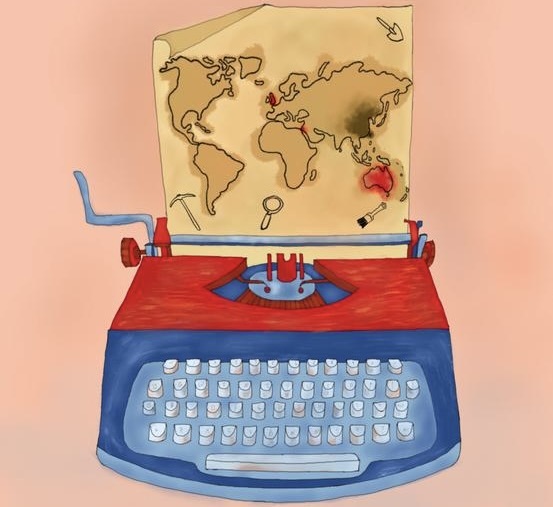
American Association for the Advancement of Science (AAAS)—A new assessment of U.S. media coverage of archaeological studies has found notable discrepancies in news about archaeological work conducted in different regions. The findings show that only 32% of 1,155 papers published in 7 different scientific journals from 2015 to 2020 earned coverage in 1 of 15 major U.S. news outlets – and that discoveries in China/Taiwan received 3 times less U.S. media attention than those featuring research in Israel/Palestine, Australia, or the U.K. Because of the cutthroat nature of today’s news landscape, many peer-reviewed studies do not receive mass media coverage. Importantly, studies that don’t reach the public don’t contribute to popular understandings of science. “Skewed coverage may be particularly charged for archaeology, a field with large public interest,” Bridget Alex and colleagues write. They argue that news coverage favoring discoveries in certain regions or cultures can “create a false impression that only those ancestries made great achievements in the past. Unreported or under-reported regions may be perceived as ‘primitive’ or lacking hallmarks of civilization.” Here, Alex et al. quantified archaeological coverage by U.S. and global outlets, assessing press attention from 1,155 archaeological papers in 1 specialist journal (Antiquity) and 6 generalist journals (Science, Nature, Science Advances, Nature Communications, Scientific Reports, and Proceedings of the National Academy of Sciences) from 2015 to 2020. They used the news tracking platform Altmetric and the press release posting platform EurekAlert! to observe trends, and also calculated a U.S.-specific news score based on a paper’s mention in 15 U.S. major outlets or aggregators (Yahoo, Google, MSN, The New York Times, The Washington Post, FOX, ABC, CNN, National Geographic, Discover, New Scientist, Newsweek, Scientific American, Forbes, and Los Angeles Times). The U.S. news score did not incorporate Associated Press coverage. Results showed that 68% of these papers had no coverage by U.S. sources. Globally, 48.3% of papers had no coverage in global news outlets according to Almetric. Coverage within the U.S. depended on the journal (correlating heavily with impact factor) and whether the authors had distributed a press release. Of note, EurekAlert! press releases often are password-protected and so not all promotion efforts could have been captured. Primarily, stories favored Paleolithic archaeological research and, secondarily, prioritized studies about early bread, beer, wine, or cannabis. Inspired by disparate coverage of two studies published in 2021 on ancient China and ancient Egypt respectively, the authors then examined geographic coverage patterns. Regression modeling showed that research covering archaeology in Israel/Palestine, the U.K., and Australia earned 3 times more coverage in at least 1 U.S. news outlet than papers covering archaeological work in China/Taiwan. “The findings point to actionable measures for researchers, press office workers, journalists, and news editors to enhance the geographic and cultural diversity of archaeology reported in U.S. press,” the authors write.
Article Source: AAAS news release.
*Regional Disparities in U.S. Media Coverage of Archaeology Research, Science Advances, 2-Jul-2025. www.science.org/doi/10.1126/sciadv.adt5435
Cover Image, Top Left: Art by Shenyi Li

American Association for the Advancement of Science (AAAS)—Neanderthals were rendering animal bones for grease – extracting more nutrients from carcasses – in present-day Germany roughly 125,000 years ago, research suggests. The discovery of a Neanderthal “fat factory” at an Interglacial Paleolithic site substantially pushes back estimates for when hominins began practicing this type of resource intensification. The ability to get extra calories by harvesting bone marrow and grease has played a critical role in humanity’s evolution; better diets helped humans live longer and reproduce more. Until now, most signs of resource intensification have been found at Upper Paleolithic sites around 28,000 years ago, well after Neanderthals became extinct. Lutz Kindler and colleagues reveal that Neanderthals performed resource intensification far earlier in the Homo genus’s evolution, as far back as 125,000 years ago. They analyzed remains from 172 large animals (horses, deer, and bovids) at the Neumark-Nord (NN2/2B) site in present-day Germany. The data*, alongside more than 16,500 flint artifacts, stone manuports, and other items indicating fire use, showed that Neanderthals transported the animals to this 50-square-meter area to fracture bones for rendering into grease. “The evidence from NN2/2B constitutes the earliest clear case of intensive grease-rendering yet documented for the Paleolithic,” Kindler et al. write. The find showcases “a substantial investment by the site’s occupants of both time and effort aimed at retrieving precious lipids from a large number of prey animals,” they conclude.
____________________________
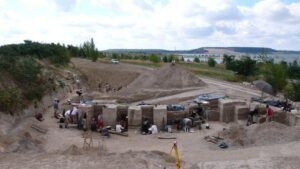
Year -round excavations. The Neumark-Nord 2/2B site was excavated through year-round campaigns by a core team from 2004 to 2009, alongside an international field school that included more than 175 students in total. Roebroeks, Leiden Univ
____________________________

Massive bone processing. At the Neumark-Nord 2 site, near the margin of a shallow pool, there is a dense concentration of bones from more than 170 larger mammals (highlighted in blue), mixed with flint artifacts (red) and hammer stones (red). All bones larger than 3 cm were carefully recorded during excavation and plotted together, creating the impression of a “bone floor” produced by Neanderthal activity at the site. Many of the bones were found in rounded depressions at the base of the excavation layer, as shown in the insets. These depressions represent the final stage of excavation, when most of the bones had already been removed, leaving only the remaining bone fragments at the bottom. Kindler, LEIZA-Monrepos
____________________________
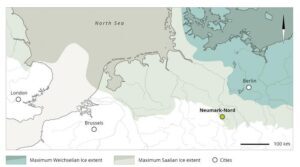
Location of Neumark-Nord (Germany). The site’s position is depicted relative to the maximum extent of the Saalian and Weichselian glaciations. Kindler et al., Sci. Adv. 11, eadv1257
____________________________
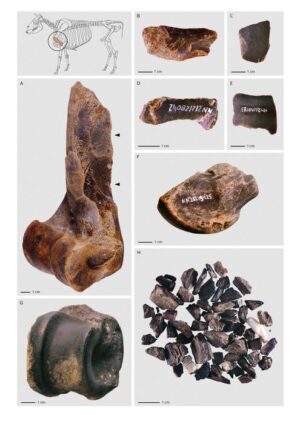
From complete bones to tiny fragments. At the Neumark-Nord 2/2B sites, imported bones were initially smashed open to extract marrow from the hollow cavities (see A; arrows indicate hammerstone impacts on an aurochs humerus). Afterward, the bones were crushed and chopped into smaller pieces (shown in B to F, again from a humerus as seen in A) to facilitate the extraction of grease from both the spongy and compact bone tissue. Approximately 2,000 tiny bone fragments accidentally came into contact with fire after boiling, resulting in typical coloration (ranging from dark brown and black to white) and texture commonly found in heated bones. Kindler, LEIZA-Monrepos
____________________________
Article Source: AAAS news release.
*Large-scale Processing of Within-Bone Nutrients by Neanderthals, 125,000 years ago, Science Advances, 2-Jul-2025. www.science.org/doi/10.1126/sciadv.adv1257
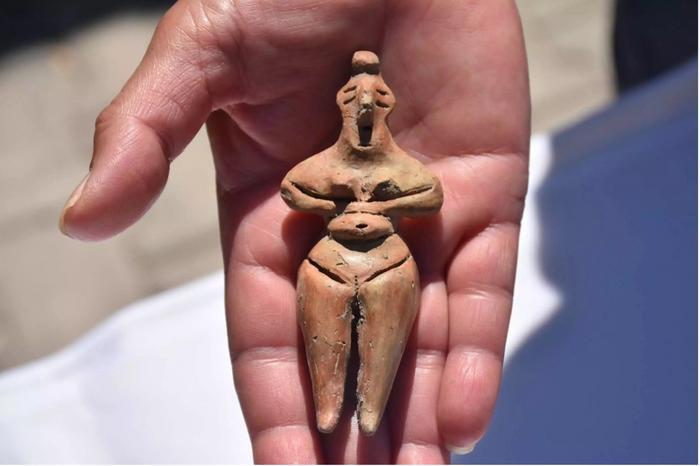
University of Lausanne—The transition to agriculture and a sedentary lifestyle is one of the great turning points in human history. Yet how this Neolithic way of life spread from the Fertile Crescent across Anatolia and into the Aegean has been hotly debated. A Turkish-Swiss team offers important new insights, by combining archaeology and genetics in an innovative way.
How open are people to experimenting with new ways of life? Did farming spread from its origins in Anatolia to neighboring regions by farmers migrating? Or was it rather local hunter-gatherers adopting their neighbors’ ways of life? A new study, published in Science, now reconciles these opposing views. The authors find that this massive cultural change occurred through both phenomena – depending on the region and the period.
The research, led by geneticists and archaeologists at Middle East Technical University (METU) and Hacettepe University in Ankara (Turkey), and the University of Lausanne (UNIL, Switzerland), sheds light on a major turning point in human history. The team’s work shows that cultural changes took place not only due to the movement of people, but also through spread of ideas. “In some regions of West Anatolia, we see the first transitions to village life nearly 10,000 years ago. However, we also observe thousands of years of genetic continuity, which means that populations did not migrate or mix massively, even though cultural transition was definitely happening,” explains Dilek Koptekin, the study’s first author.
A missing chapter in the Neolithic story
Previous research had already shown how agriculture gradually replaced hunting and gathering in Europe after 6,000 BCE, through the movement of farmers out of Anatolia (modern-day Turkey). But what happened before this tipping point, especially in Anatolia, remained unclear. “Our study allows us to go back in time – to events that were mainly a matter of speculation up to now,” says Koptekin.
This advancement was possible by sequencing the genome of a 9,000-year-old individual from West Anatolia, the oldest yet in the region. Combining this genome with 29 new paleogenomes as well as published data, the researchers found surprising genetic continuity in West Anatolia across seven millennia. “Genetically speaking, these people were mainly locals, meaning that their ancestors had not recently arrived from elsewhere. Yet their material culture evolved rapidly: they moved from caves to houses, and adopted new tools and rituals from afar. This suggests that these communities adopted Neolithic practices by cultural exchange rather than population replacement,” says computational biologist Anna-Sapfo Malaspinas from UNIL.
How exactly did that happen? “The answer lies in what we call ‘background mobility’,” explains geneticist Mehmet Somel from METU. “This means a low but steady movement of individuals around different regions, perhaps linked to exchange, finding partners, or other motivations. These encounters then led to the sharing of material and ideas.” Such movement is illustrated by traces of obsidian, a volcanic glass used for tools, found in western Anatolia but sourced from central Anatolian volcanoes hundreds of kilometers away. Materials, and with them ideas, were apparently on the move.
Ideas move further than people
Seeking deeper insights into this mobility, the team used an innovative approach, combining ancient DNA with archaeological material data. The researchers scoured hundreds of articles and quantified archaeological features such as pottery types, tools, and architectural remains. This allowed them to systematically compare materials with the genetic profiles of individuals buried at the same sites. “By giving quantitative values to the archaeological data, we were able to directly compare large amounts of data across different sites for the first time,” specifies archaeologist Çiğdem Atakuman from METU. The team thereby traced not only who moved where, but also how ideas and practices circulated.
The scientists’ findings challenge previous assumptions that new tools or objects necessarily indicate the arrival of a new population. “Archaeologists have this proverb, ‘Pots don’t equal people’. Our study confirms this notion,” comments Dilek Koptekin.
An evolving mosaic
But this is not the whole story. In some areas of Anatolia, genetic data revealed both mobility and admixture of populations around 7,000 BCE. Here, new groups moved in, bringing both different genes and different practices. In the Aegean region, too, a later wave of population movement introduced further cultural elements that would eventually spread into Europe.
“These types of migration events, which leave genetically visible shifts, probably comprised a small fraction of movement happening compared to background mobility,” says Füsun Özer from Hacettepe University. “The Neolithic, in this view, was not a single process, but a patchwork of transformations, combining cultural adoption, mobility, and at times, migration.” Koptekin adds, “Humans have always been adaptive and inclined to change their way of living. We don’t need crises or big migration events to bring about change.”
Conceptualized and led primarily by researchers based in Turkey, the study underscores the importance of supporting research in regions directly connected to the questions under investigation. For Anna-Sapfo Malaspinas, it is a valuable example of how extending large-scale funding opportunities beyond established scientific hubs strengthens underrepresented research communities. “Our collaboration shows how we, as a scientific community, should move forward to create a more inclusive and globally balanced research landscape,” concludes the biologist.
The methodological leap achieved in this study, integrating genomic and archaeological data at large scale for the first time, marks a turning point for prehistoric research. It allows future research to move beyond simple models and embrace more complex realities of human history.
_______________________________

Excavations at Çatalhöyük, Neolithic site in Central Anatolia. Christopher J. Knüsel
_______________________________

Excavations performed at Girmeler, Turkey. Tlos Excavation Archive
_______________________________

Researchers performing excavation at Bahçelievler, Bilecik, Turkey. Erkan Fidan
_______________________________
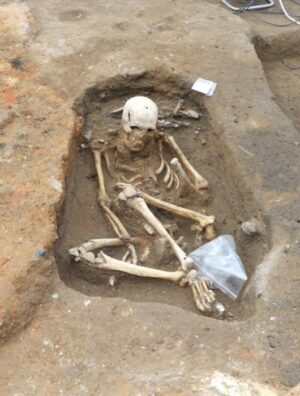
Burial site at Pendik Höyük, Istanbul, Turkey. Mehmet Özdoğan
_______________________________
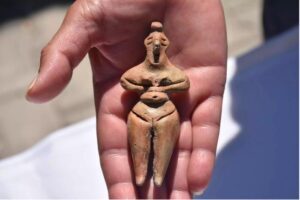
Figurine from Ulucak Höyük in West Anatolia. Ulucak Höyük Excavation Archive
_______________________________
Article Source: University of Lausanne news release.
*Out-of-Anatolia: cultural and genetic interactions during the Neolithic expansion in the Aegean, Science, 26-Jun-2025. 10.1126/science.adr3326

University of Tokyo—When and where the earliest modern human populations migrated and settled in East Asia are relatively well known. However, how these populations moved between islands on treacherous stretches of sea is still shrouded in mystery. In two new papers, researchers from Japan and Taiwan led by Professor Yousuke Kaifu from the University of Tokyo simulated methods ancient peoples would have needed to accomplish these journeys, and they used period-accurate tools to create the canoes to make the journey themselves.
Evidence suggests that around 30,000 years ago, humans made a sea crossing — without maps, metal tools or modern boats — from what is now called Taiwan to some of the islands in southern Japan, including Okinawa. To find out exactly how this crossing was made, a team led by Kaifu performed various simulations and experiments, including the use of physical recreations, to learn the most plausible way this crossing was achieved. Of the two newly published papers, one used numerical simulations to cross one of the strongest currents in the world called the Kuroshio. The simulation showed that a boat made using tools of the time, and the right know-how, could have navigated the Kuroshio. The other paper detailed the construction and testing of a real boat which the team successfully used to paddle between islands over 100 kilometers apart.
“We initiated this project with simple questions: ‘How did Paleolithic people arrive at such remote islands as Okinawa?’ ‘How difficult was their journey?’ ‘And what tools and strategies did they use?’” said Kaifu. “Archaeological evidence such as remains and artifacts can’t paint a full picture as the nature of the sea is that it washes such things away. So, we turned to the idea of experimental archaeology, in a similar vein to the Kon-Tiki expedition of 1947 by Norwegian explorer Thor Heyerdahl.”
In 2019, the team constructed a 7.5-meter dugout canoe called Sugime, built from a single Japanese cedar trunk, using replicas of 30,000-year-old stone tools. They paddled it 225 kilometers from eastern Taiwan to Yonaguni Island in the Ryukyu group, which includes Okinawa, navigating only by the sun, stars, swells and their instincts. They paddled for over 45 hours across the open sea, mostly without any visibility of the island they were targeting. Several years later, the team is still unpicking some of the data they created during the experiment, and use what they find to inform or test models about various aspects of sea crossings in that region so long ago.
“A dugout canoe was our last candidate among the possible Paleolithic seagoing crafts for the region. We first hypothesized that Paleolithic people used rafts, but after a series of experiments, we learned that these rafts are too slow to cross the Kuroshio and are not durable enough,” said Kaifu. “We now know that these canoes are fast and durable enough to make the crossing, but that’s only half the story. Those male and female pioneers must have all been experienced paddlers with effective strategies and a strong will to explore the unknown. We do not think a return journey was possible. If you have a map and know the flow pattern of the Kuroshio, you can plan a return journey, but such things probably did not take place until much later in history.”
To understand whether such a journey could have been made in different circumstances, the team also used advanced ocean models to simulate hundreds of virtual voyages. These simulations tested different starting points, seasons and paddling strategies under both modern and ancient ocean conditions.
“I major in oceanography and use numerical methods and particle tracking techniques to research things like eel and salmon migrations, pumice drift after volcanic eruptions, and oil spills in the Gulf of Mexico,” said Yu-Lin Chang from the Japan Agency for Marine-Earth Science and Technology, and a visiting researcher at UTokyo and lead author of one of the papers in this study. “The Kuroshio Current is generally considered dangerous to navigate. I thought if you entered it, you could only drift aimlessly. But the results of our simulations went far beyond what I had imagined. I’m pleased this work helped illuminate how ocean voyages may have occurred 30,000 years ago.”
The simulations helped fill gaps that a one-time experiment could not. They revealed that launching from northern Taiwan offered a better chance of success than from further south, and that paddling slightly southeast rather than directly at the destination was essential for compensating against the powerful current. These findings suggest a high level of strategic seafaring knowledge among early modern humans.
“Scientists try to reconstruct the processes of past human migrations, but it is often difficult to examine how challenging they really were. One important message from the whole project was that our Paleolithic ancestors were real challengers. Like us today, they had to undertake strategic challenges to advance,” said Kaifu. “For example, the ancient Polynesian people had no maps, but they could travel almost the entire Pacific. There are a variety of signs on the ocean to know the right direction, such as visible land masses, heavenly bodies, swells and winds. We learned parts of such techniques ourselves along the way.”
_____________________________

The team set out in their handmade canoe, making the entire experience as authentic as possible. ©2025 Kaifu et al. CC-By-ND. ©2025 Kaifu et al. CC-By-ND
_____________________________

The team used replica tools and a real tree. ©2025 Kaifu et al. CC-BY-ND ©2025 Kaifu et al. CC-By-ND
_____________________________
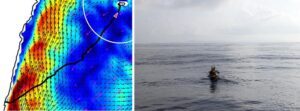
(Left) GPS tracking and modeling of ocean currents toward the end of the experimental voyage. (Right) The team around the time of the left image. ©2025 Kaifu et al. CC-BY-ND ©2025 Kaifu et al. CC-By-ND
_____________________________
Article Source: University of Tokyo news release.
*Traversing the Kuroshio: Paleolithic migration across one of the world’s strongest ocean currents, Science Advances, 25-Jun-2025. 10.1126/sciadv.adv5508
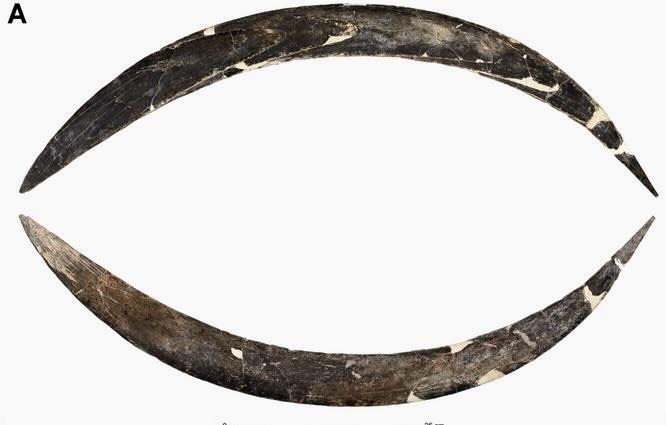
PLOS—Article Abstract—Beginning with the Early Aurignacian, Homo sapiens demonstrated an enhanced symbolic capacity, expanding artistic expressions from body decoration to portable art and aesthetically refined tools. These artistic endeavors, often intertwined with utilitarian purposes, have sparked debates regarding their symbolic versus functional roles. Among these remarkable artifacts is a complete mammoth tusk boomerang from Layer VIII of Obłazowa Cave, Poland, found in association with a human phalanx. Determining its precise chronology and cultural context is critical for understanding the emergence and variability of symbolic behaviors among early Homo sapiens groups in Europe. This study refines the chronology of the Early Upper Paleolithic occupation of Layer VIII at Obłazowa Cave through radiocarbon dating of several bones and the human fossil found near the ivory boomerang. Bayesian modeling places the site’s main occupation phase between 42,810−38,550 cal BP (95,4% probability). The mammoth-ivory boomerang, calibrated to 42,290−39,280 cal BP with a 95.4% probability, emerges as one of Europe’s oldest known examples of this complex tool, exemplifying technological and symbolic innovation at Obłazowa Cave. This multi-disciplinary research underscores the importance of integrating advanced methodologies to explore cultural practices during the Upper Paleolithic. The findings not only deepen our understanding of Homo sapiens’ adaptive strategies but also highlight the nuanced interplay of technology, symbolism, and environmental interaction during the earliest phases of human dispersals in Central Europe.
_____________________________

The Boomerang made of mammoth tusk of Obłazowa Cave from layer VIII. Talamo et al., 2025, PLOS One, CC-BY 4.0 (https://creativecommons.org/licenses/by/4.0/)
_____________________________
Article Source: PLOS news release
*Boomerang and bones: Refining the chronology of the Early Upper Paleolithic at Obłazowa Cave, Poland, PLOS One, 25-Jun-2025. 10.1371/journal.pone.0324911

UNIVERSITY PARK, Pa. — An ancient society near the southern shores of Lake Titicaca in modern-day Bolivia was once one of the continent’s most powerful civilizations. Known as Tiwanaku, the ancient society is widely considered by archaeologists to be one of the earliest examples of civilization in the Andes and a precursor of the Inca empire, but it mysteriously disappeared about a thousand years ago. Now, a team led by scientists at Penn State and in Bolivia have discovered a Tiwanaku temple, shedding new light on what the society looked like in its prime.
Much about the Tiwanaku civilization remains unknown, explained José Capriles, Penn State associate professor of anthropology and lead author on a study* about the temple discovery published today (June 24) in the journal Antiquity.
“Their society collapsed sometime around 1000 CE and was a ruin by the time the Incas conquered the Andes in the 15th century,” Capriles said. CE refers to the common era of the current calendar. “At its peak, it boasted a highly organized societal structure, leaving behind remnants of architectural monuments like pyramids, terraced temples and monoliths, most of which are distributed in sites around Lake Titicaca and, while we know Tiwanaku’s control and influence extended much further, scholars debate how much actual control over distant places it had.”
The newly discovered temple complex is located roughly 130 miles south of Tiwanaku’s established historical site, on top of a hill that was known to local Indigenous farmers but was never explored in depth by researchers due to its unassuming location. However, the position of the site is actually very strategic, Capriles explained.
At the time of Tiwanaku, the spot connected three main trade routes for three vastly different ecosystems: the productive highlands around Lake Titicaca to the north, the arid Altiplano ideal for herding llamas to the west and the agriculturally productive eastern Andean valleys of Cochabamba to the east.
As such, the researchers said they understood that the site must have held some importance for connecting people. Capriles explained that people moved, traded and built monuments in places of significance throughout the arid mountain landscape. After noticing an unmapped quadrangular plot of land, the researchers used various techniques to visualize the area.
“Because the features are very faint, we blended various satellite images together,” Capriles said. “We also conducted a series of UAV, or unmanned aerial vehicle, flights to acquire better pictures. By means of photogrammetry, a technique that uses photos to construct a 3D approximation, we got a more detailed rendering of the structure and its topography.”
Stone alignments revealed an ancient temple, called Palaspata after the native name for the area. The temple complex is approximately 125 meters long by 145 meters wide — about the size of a city block — and includes 15 quadrangular enclosures arranged around a rectangular inner courtyard. Its layout seems aligned to perform rituals following the solar equinox, the moment when the sun is directly above the equator, Capriles said. Using data they collected, the researchers developed a reconstruction to reveal what the ancient temple might have looked like.
The surface of the temple contained numerous fragments of keru cups. The cups were used for drinking chicha, a traditional maize beer, during agricultural feasts and celebrations and point to the temple’s function as a central hub for trade, Capriles said. The fact that maize was not locally grown but cultivated in the Cochabamba valleys versus the high-altitude temple site underscores the temple’s importance in facilitating access to various goods, including food, and connecting different culinary traditions, he added.
Capriles said the temple likely served a religious purpose, evidenced by the designated ritual areas as well as by its physical connection mediating trade and harvest distribution.
“Most economic and political transactions had to be mediated through divinity, because that would be a common language that would facilitate various individuals cooperating,” he said, as religion was often the common ground that connected different groups.
The discovery was a surprise even to the local inhabitants, explained Justo Ventura Guarayo, mayor of the municipality of Caracollo where the site is located.
“The archaeological findings at Palaspata are significant because they highlight a crucial aspect of our local heritage that had been completely overlooked,” Ventura Guarayo said. “This discovery is vital for our community, and we believe its documentation will be invaluable for promoting tourism and showcasing our region’s rich history.”
He added that the city is working with state and national authorities to ensure proper protection and preservation of the site, following guidance from archaeology experts like Capriles.
“With more insight into the past of this ancient site, we get a window into how people managed cooperation, and how we can materially see evidence of political and economic control,” Capriles added. “There’s still so much to discover that we don’t know about, and that could be hiding in plain sight. It just requires opening your eyes to see what’s out there.”
The researchers worked with the Bolivian Ministry of Cultures, Decolonization, and Depatriarchalization to export samples, which were dated at the Penn State’s Institute of Energy and the Environment Radiocarbon Dating Lab.
This paper was co-authored with Sergio Calla Maldonado, a Bolivian graduate student at Universidad de Granada; Juan Pablo Calero, a Bolivian architect; and Christophe Delaere, a Belgium research associate at Université libre de Bruxelles. The U.S. National Science Foundation funded this research in part via grants BCS-2015924 and DEB-2208411.
__________________________
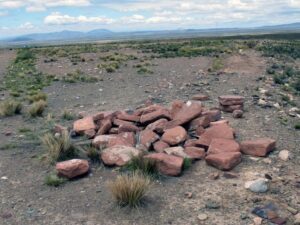
The newly discovered temple complex is located roughly 130 miles south of Tiwanaku’s established historical site, on top of a hill that was never explored in depth by researchers due to its unassuming location. Credit: José Capriles / Penn State. CC BY-NC-ND 4.0, Wikimedia Commons
__________________________

The surface of the temple contained numerous fragments of keru cups. The cups were used for drinking chicha, a traditional maize beer, during agricultural feasts and celebrations and point to the temple’s function as a central hub for trade. Credit: José Capriles / Penn State. CC BY-NC-ND 4.0, Wikimedia Commons
__________________________
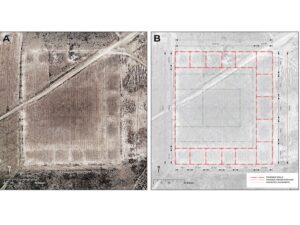
The temple’s layout seems aligned to perform rituals following the solar equinox, the moment when the sun is directly above the equator. Using data they collected, the researchers developed a reconstruction to reveal what the ancient temple might have looked like. Credit: José Capriles / Penn State. CC BY-NC-ND 4.0, Wikimedia Commons
__________________________
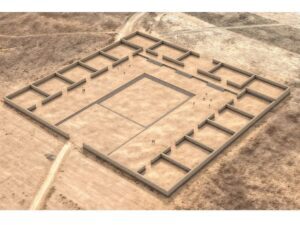
Stone alignments revealed an ancient temple, called Palaspata after the native name for the area. The temple complex is approximately 125 meters long by 145 meters wide — about the size of a city block — and includes 15 quadrangular enclosures arranged around a rectangular inner courtyard. This is a digital reconstruction of the temple. Credit: José Capriles / Penn State. CC BY-NC-ND 4.0, Wikimedia Commons
__________________________
At Penn State, researchers are solving real problems that impact the health, safety and quality of life of people across the commonwealth, the nation and around the world.
For decades, federal support for research has fueled innovation that makes our country safer, our industries more competitive and our economy stronger. Recent federal funding cuts threaten this progress.
Learn more about the implications of federal funding cuts to our future at Research or Regress.
__________________________
Article Source: Penn State University news release.
*José M. Capriles, et al., Gateway to the east: the Palaspata temple and the south-eastern expansion of the Tiwanaku state, Antiquity 2025 Vol. 99 (405): 831–849 https://doi.org/10.15184/aqy.2025.59
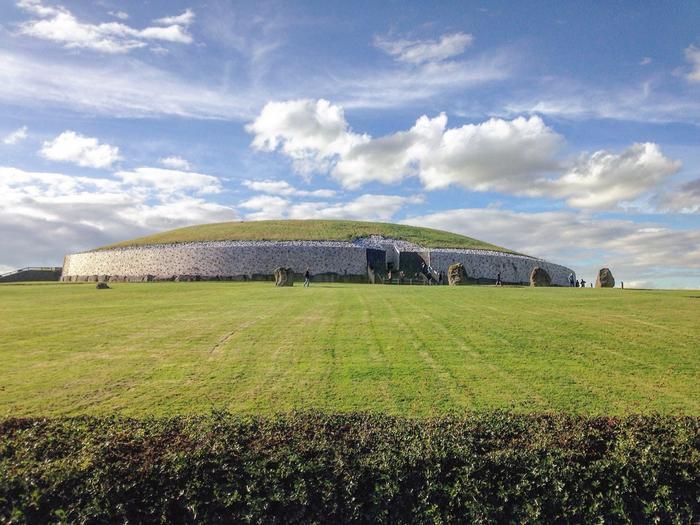
University College Dublin—New research cast doubts over suggestions an incestuous social elite ruled over the ancient people of Ireland, 5500 years ago.
A paper led by researchers from University College Dublin, in collaboration with University of Bergen, Australian National University, University of York, University of Exeter, University of Liverpool, and Archaeological Consultancy Services Unit (a commercial archaeological company), has questioned the belief that burial within the ‘mega’ passage tomb of Newgrange was the preserve of kings and other dignitaries, who represented a dynasty that practiced incest.
Such claims were widely reported in the media following the discovery that a skull fragment found inside the tomb chamber of this Stone Age monument came from a man who was the product of either a brother-sister or parent-child pairing.
This finding, together with the identification of distant relatives from other passage tombs across the island, led to the suggestion of incestuous elites ruling in Neolithic Ireland.
This was based on comparison with royal dynasties or “god-kings” that practiced incest, such as the pharaohs of ancient Egypt and leaders of the Inca Empire.
However, publishing their findings in Antiquity, Associate Professor Jessica Smyth and Associate Professor Neil Carlin, UCD School of Archaeology, point out that no other incestuous unions have been identified in Neolithic Ireland and Britain, and that there is a lack of evidence for inbreeding across prehistoric Europe.
They also say the evidence found at the site does not support the existence of a ‘king’ of Newgrange or any hereditary power or dynasty with a shared ancestry.
“People were definitely being selected for burial in passage tombs – the whole community does not end up in these monuments. However, we don’t know the reasons behind this selection, and why they were thought to be special,” said Professor Smyth.
“Unlike today, bodies don’t tend to be buried ‘whole’ or ‘intact’ in this time period. Before they end up in megalithic monuments, bodies are broken down, sometimes cremated and even circulated around their communities”.
“For these reasons, the media claims that there was an incestuous ruling elite in Stone Age Ireland did not match our understanding of society at this time, it did not fit the evidence very well,” added Professor Carlin.
Older than Stonehenge and the Pyramids of Giza, Newgrange is believed to have been built by a farming community that prospered in the Boyne Valley, County Meath, some 5,000 years ago.
Dated to 3340 – 3020 BC, the skull fragment, referred to as NG10, revealed the rare case of incest, which led to claims in 2020 that the individual was a high-status ruler, with press coverage dubbing them a “god-king.”
However, Professors Smyth and Carlin argue that these conclusions relied heavily on unsuitable comparisons with hierarchical societies where incest was limited to ruling families, such as in ancient Egypt, while ignoring examples of incest in non-elite or egalitarian communities.
“A one-off example of incest is a shaky foundation on which to reconstruct an elite, let alone a specific social [hierarchy],” said the authors.
The genetic clustering in passage tombs, such as at Newgrange, typically reflects very distant biological relationships – like second cousins or great-great-great-grandparents – rather than close familial ties.
This, they argue, suggests burial practices were not strictly determined by lineage. Rather than these being the burials of elite rulers or a ruling dynasty, tombs were places where people made their kin through a range of practices, including living, working and burying their dead together.
“We now have some really great examples of monuments elsewhere in Europe that contain people with very close biological ties – parents, children, grandparents etc. This sort of aDNA evidence is much closer to the idea of a lineage or dynasty. We do not see this evidence in Irish passage tombs,” said Professor Smyth.
Given the renown of Newgrange, the authors said there had been surprisingly little focus on the people or the traces they left inside the passage tomb. Newgrange was rediscovered in AD 1699 and its interior had been heavily disturbed prior to its modern excavation in the 1960s.
“Burnt and unburnt fragments from just five people were recovered from the 1960s excavations of the tomb. Due to the high levels of disturbance in the centuries before that, we don’t know if this number was originally much higher,” said Professor Carlin.
Historically, Irish megalithic monuments, and passage tombs in particular, have been examined in isolation from the other structures and social activities of the communities that built and used them.
This has hindered the ability to identify who, if anyone, was preferentially chosen for deposition within.
“[It] doesn’t make sense to continue to focus so exclusively on forms of stable, individual rule, in Neolithic Ireland and elsewhere, when the evidence is insufficient to support such claims,” said the authors.
“Doing so perpetuates the myth that only important individual males were socially active, and downplays the contribution made by collective action in the prehistoric past.”
___________________________
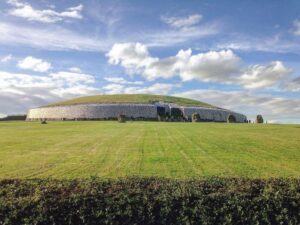
Older than Stonehenge and the Pyramids of Giza, Newgrange is believed to have been built by a farming community that prospered in the Boyne Valley, County Meath, some 5,000 years ago. Tjp Finn
___________________________
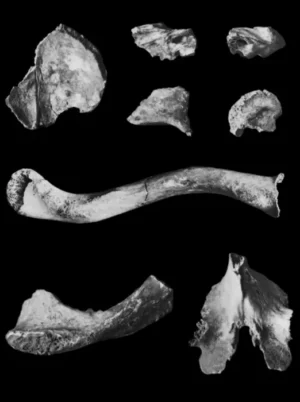
Unburnt bone fragments recovered from inside Newgrange during the 1960s excavations. O’KELLY, MJ 1982
___________________________

Location of burnt and unburnt bone lots recovered during Professor Michael J. O’Kelly’s excavations of the the megalithic passage tomb at Newgrange. O’KELLY, MJ 1982
___________________________
Article Source: University College Dublin news release.
*The ‘king’ of Newgrange? A critical analysis of a Neolithic petrous fragment from the passage tomb chamber, Antiquity, 24-Jun-2025. 10.15184/aqy.2025.63
Eva Miller is a British Academy Postdoctoral Fellow at UCL History, whose research explores how modern scholars and artists have conceived of the ancient past and theorized the importance of “origins.” She is the author of Early Civilization and the American Modern: Images of Middle Eastern Origins in the United States, 1893–1939 (UCL Press, 2024), and editor (with G. Crouzet) of Finding Antiquity, Making the Modern Middle East: Archaeology, Empires, Nations (Bloomsbury, 2025). Among other areas, she has worked on self-Orientalizing Jewish art, cryptozoological investigations of living dinosaurs attested in ancient Babylonian artifacts, anthropological theories on the evolution of languages and writing, and the role of art in science museums. She originally trained as an Assyriologist, earning her doctorate from the University of Oxford in the Faculty of Asian and Middle Eastern Studies.

In the early 20th century, architects turned to a newly discovered past to craft novel visions of the future: the ancient history of Mesopotamia. Eva Miller traces how both the mythology of Babel and reconstructions of stepped-pyramid forms influenced skyscraper design, speculative cinema in the 1910s and 20s, and, above all else, the retrofuturist dreams of Hugh Ferriss, architectural delineator extraordinaire.
In a dramatic, monochrome rendering in ink and charcoal, a fractal of pyramids and steps regenerates at different scales and angles. Vertiginous towers, the tallest outgrowing the frame, ascend from a base of tiered structures—or ziggurats—rising in regular terraces. The roofs of lower blocks are dotted with minuscule trees that echo the larger, man-made shapes around them. They are the only living things visible at this scale, but an accompanying text tells us that this skyline is populated with people who enjoy the city’s elaborate roof gardens, sun porches, and open-air swimming pools.
This was how Hugh Ferriss imagined the future of urbanism in his treatise Metropolis of Tomorrow (1929). Born in St. Louis in 1899, Ferris trained as an architect and forged a career for himself in a role for which he invented his own job title: “architectural delineator,” bringing other architects’ projects to life on paper. His portfolio, now held by the Avery Art and Architecture Library at Columbia University, speaks to his proximity to numerous major works of modern architecture and engineering, including renderings of Rockefeller Center, Works Progress Administration infrastructure projects, World’s Fairs, United Nations buildings, and various mysterious, unnamed structures of his own imagination—visions swimming up to us through Ferriss’ dramatic wash of line and shadow.
City of Tomorrow
Metropolis is a portfolio of Ferriss’ images, annotated with reflections on the work he had participated in and the architectural changes he had witnessed during recent decades, when American cities, especially his adopted home of New York, exploded upward. He made modest trend forecasts for the near future: glass, he predicted, would be huge (true); hydroplanes would be everywhere (sadly not).
In the final, most memorable section of the book, he sketched a distant City of Tomorrow. This city would be planned along rational lines to maximize human health and spiritual happiness through a three-part plan with districts for art, science, and business, each centered on aesthetically appropriate superblocks.
Ferriss’ dramatic depictions of towering skyscrapers and lofty perspectives became, as media scholar Eric Gordon argues, the means by which “the image of the American urban future in the popular imagination took shape.” His futurism anticipated and influenced Norman Bel Geddes, as he created his Futurama for the 1939 New York World’s Fair, the Walt Disney Company’s Tomorrowland, TV’s “The Jetsons,” and numerous other prognostications of the rational planned city, the elevated expressway, and the heliport.
Yet Ferriss’s forward-looking vision also repeatedly evoked the ancient past. The pyramid skyscraper that he promoted was, in his own description, a “modern ziggurat,” the monumental architectural form of ancient Mesopotamian cities. Centered in modern-day Iraq, both Assyria and Babylon were geopolitical superpowers of the first millennium BCE, empires discussed in both biblical and classical traditions, which had once been considered lost to the desolating force of time. Beginning in the mid-19th century, the crumbled remains of ziggurat towers had inspired speculative reconstructions.
By the 1920s, German excavations had exposed the well-preserved urban fabric of Babylon’s 6th-century BCE city walls and gates, parts of which were also partially reconstructed in Berlin’s Pergamon Museum, looking rather Art Nouveau. Meanwhile, the nearby city of Ur was being excavated by thousands of workers in digs sponsored by the British Museum and the Penn Museum, turning up mass burials of gold-bedecked bodies. These new discoveries stirred those who read about them in the popular press to imagine an antiquity that was also somehow strangely modern: The women’s fashion in the Ur burials led to press jokes about the dead bodies being traces of the original flappers.
Ferriss was clearly not the only person who thought there might be some connection between the urban spaces of ancient Babylon and Assyria and the cutting edge of modernity. At a time when being modern, especially in architecture, often meant explicitly rejecting historical reference, it is notable how much the idea of an original urban form structured visions of the future.
Learning From the Past
At the time of Ferriss’ Metropolis, a question had bedeviled modern architects for decades: What could be learned from the traditions of the past? Were the great buildings of antiquity, particularly of classical Greece and Rome, eternal blueprints, a standard never to be bettered? Architectural training programs in the United States during the early 20th century suggested this was the case. But increasing numbers of builders worried that the adulation of the past produced dead, stagnant structures that were irrelevant to the modern world.
Wherever they came down on this matter (and there was a wide middle ground), numerous commentators with different aesthetic preferences could agree on damning random and eclectic historical borrowing—even if they might have disagreed on what constituted an example of that tendency.
Perhaps no writer treated this historicizing, classicizing eclecticism with more vitriol than the perpetually worked-up Ayn Rand. Her architectural-philosophical melodrama The Fountainhead, published in 1943 but set during the years that Ferriss was writing, was an insightful, if unsubtle, rant against these trends. She castigated architects who “competed on who could steal best, from the oldest source and from the most sources at once,” resulting in “shingled post offices with Doric porticos, brick mansions with iron pediments, lofts made of twelve Parthenons piled on top of one another.” She imagined a benighted public who celebrated a skyscraper which “offered so many columns, pediments, friezes, tripods, gladiators, urns, and volutes that it looked as if it had not been built of white marble but squeezed out of a pastry tube.”
Ferriss was against this kind of inauthenticity, too, advocating that modern buildings must follow the diktat of America’s great modernist innovator, Louis Sullivan: Form ever follows function. Architects of the future, Ferriss assures us:
“…will dismiss, as sentimentality, the notion that architectural beauty was once and for all delivered to the builders of ancient times. The employment of modern construction to support what are little more than classic or medieval stage sets, they will look upon as, at its most harmless, a minor theatrical art, but no longer as being Architecture.”
He mocked this kind of “stage set” architecture in an illustration of the “Reversion to Past Styles” for Metropolis. He bemoaned this tendency’s persistence “despite the logical, and sometimes impassioned, pleas of leaders in modern design.” Still, stacks of “the same conventional forms” were appearing, and Ferriss believed it was his “duty to show what would happen if architects continued piling Parthenons upon skyscrapers!”
Ferriss nonetheless found in the past some examples of an ethos, if not an aesthetic, to imitate. He explained: “It can be recalled that there have been periods in the past when architects must have been quite aware of the influence of Architecture and consciously employed it for a specific object. Moreover, it is precisely these periods that are still spoken of as the ‘great periods’ of Architecture.”
His illustrative example is the Gothic cathedral, intended by its builders, through its very form, to exert “an influence for the betterment of mankind… It would seem, in fact, that Architecture was here consciously employed for no less an object than the elevation and evolution of Man.” This decidedly futurist conception of architecture’s possible benefits (“elevation,” “evolution,” and “Man” with a capital “M”) had a venerable, historical precedent.
Ferriss’ distinction—between mere regurgitation, on the one hand, and a deeper appreciation of the eternal power of certain forms and practices, on the other—was also made by architects who agreed that there might be lessons to be drawn from the approaches of medieval and ancient civilizations. The Swiss modernist Le Corbusier, perhaps the most famous prophet of planned future cities, cited the Parthenon as the apogee of an architecture of basic geometric forms, a “pure creation of the mind,” evoking “emotion of a superior, mathematical order” and embodying a spirit of “imagination and cold reason.” He detected an analogous spirit at work in the design of the telephone, the airplane, and the automobile.
Louis Sullivan agreed. In the same article in which he argued for form to follow function, Sullivan cited rare periods when architecture was a “living art,” which had produced “the Greek temple, the Gothic cathedral, the medieval fortress”—a grouping he argued was now being joined by “the tall office building.” In all of these examples, radical designs enabled by new technologies were nonetheless produced by the same animating spirit, the same eternal dicta, as the enduringly powerful forms of the past.
The Tower of Babel and Modern Babylons
While Greek temples and Gothic cathedrals were often cited in this period as architecture done right, they were also models tarnished by poor and unsuitable imitation and inauthentic to modern materials and methods of construction. For thinkers wary of mere historical reproduction but nevertheless in search of essential or eternal forms, ancient Assyria and Babylon were appealing places to turn to due to their simultaneous associations with modernity (a “newly discovered” past) and originality.
This latter association was forged both by historians who drew on archaeological evidence to identify these civilizations of ancient Mesopotamia as the cradle of (Western) civilization and by the enduring cultural power of one of the most familiar and transmitted stories about the origins of monumental architecture: the Biblical Tower of Babel (or Babylon—merely two English renderings of the same place name).
Western artistic traditions had often visualized the Tower of Babel as a spiral, a form that Frank Lloyd Wright famously adopted and described as a ziggurat or, when turned upside down for the Guggenheim, a “tarrugiz.” As historical knowledge of ancient Iraq grew in the latter decades of the 19th and early 20th centuries, archaeological reconstructions imagined the mythical urban tower as a stepped pyramid, similar to the descriptions of Babylonian buildings by the Greek historian Herodotus.
The brief but rich story of the Tower of Babel closes the series of primordial origin myths in the first part of Genesis: the end of humanity’s childhood. “Let us build ourselves a city and a tower with its top in the heavens, and let us make a name for ourselves; otherwise we shall be scattered abroad upon the face of the whole earth,” its builders resolve. God sees a threat in this cooperative venture, for humans who could complete such a project would be unstoppable, like gods. To prevent its completion, he turns their universal language into a nonsensical babble of tongues and scatters humans across the earth.
In the early 20th century, the Tower of Babel was frequently associated with the emerging skyscraper form. The reference had an ambiguous valence. It could express unease about the changing look of modern cities and anxieties about whether experimenting with non-traditional values (architectural or otherwise) was the first symptom of societal collapse on a biblical scale.
The Tower of Babel’s link with technological hubris dovetailed with associations regarding ancient sexual immorality, derived from Herodotus’ salacious reports of ritualized prostitution in Babylon and the New Testament figure of the “Whore of Babylon” in the Book of Revelation, where Babylon was a stand-in for the Roman Empire. In the late 19th century, it was low-rise London that was most often designated “Modern Babylon” after an 1885 series of articles published in the Pall Mall Gazette by its editor W. T. Stead exposed sexual trafficking in the city; the series was entitled, with reference to Herodotus, “The Maiden Tribute of Modern Babylon.”
The “babble” that the Tower of Babel triggered could also lend itself to associations with modern polyglot cosmopolitan spaces, which were both celebrated for their variety and damned for their dangerous racial ferment.
Yet as the skyscraper came to dominate the skylines of many American cities in the 1920s, designating a city a “modern Babylon” was increasingly meant primarily to invoke its architectural form. Absent from the connotations of sexual depravity or confusion of tongues, the association of skyscrapers with the never-bettered ancient tower was often merely a form of aggrandizement, a celebration of the technological wonders modernity could produce, coupled with perhaps a tinge of nostalgic hope that modern technology might facilitate a return to cooperation and human unity of purpose.
Hence: a 1908 article on the triumphant rebuilding of post-earthquake San Francisco as a record achievement for any “ancient or modern Babylon”; a 1923 article on the skylines of New York and ancient Babylon as “growing more alike every day,” in each case a “good advertisement” for urbanism; a 1924 article describing the University of Pittsburgh’s “Cathedral of Learning” skyscraper as a new Tower of Babel uniting all scattered tongues with “all the sciences and arts of the age of steel”; a 1929 review of the painter William S. Horton’s New York skyline scenes showing “a modern Babylon, as no Babylon ever was, burning in gold and luxurious color, a city rising far above its mere human inhabitants, and dreaming the long dreams of mingled past and future”; and a 1934 description of the Boulder Dam as “Modern Babylon,” representing “the application of all the newest knowledge engineering,” yet visually “reminiscent of long bygone days.”
Here, biblical associations were joined by classical Greek accounts expressing awe at Babylon’s magnificent monumental architecture, including the seemingly mythical Hanging Gardens, a watered and planted version of the ziggurat, and a canonical Wonder of the World.
The most famous mobilization of Babylon for a vision of futurity was another, better-known, Metropolis of the 1920s: the German director Fritz Lang’s 1927 epic film. The design of its futuristic skyscraper city, home of a “new tower of Babel,” in which an underclass toiled in the bowels of factories and the rich played erotic games on rooftop gardens, was inspired by the skyline of New York. The film features a sequence in which its kindhearted, revolutionary heroine tells the biblical Tower of Babel story to a meeting of workers, rendering it as a parable about exploitation and injustice. The heroine’s evil double, most famous for her android form, appears in a dream sequence as the Whore of Babylon, in minimal clothing.
Lang’s various evocations of Babylon show that he was thinking of grandiose architecture, sexual immorality, and doomed tyrannical political powers all at once. But he was perhaps also thinking merely about what worked as a cinematic spectacle. At the time, Hollywood’s most famous depiction of ancient Babylon was D.W. Griffith’s 1916 mega hit Intolerance, which boasted massive, riotously adorned sets of the ancient city. This Orientalist extravaganza and other similar epics with biblical settings—like the Austrian Sodom und Gomorra (1922), which featured an enormous ziggurat—provided Lang with a suitably monumental cinematic vocabulary to invoke other worlds, whether long gone or yet to come.
Ferriss and the Ziggurat Form
The ziggurat-skyscraper shape that Lang detected in the New York skyline was kindled by one regulation of outsized importance: the 1916 New York City zoning law that established maximum permissible massing for new buildings in the city. This law limited the total area of a lot that a building could occupy after a certain height, meaning that buildings would need to be “stepped back” as they rose, allowing sufficient light and air to reach surrounding structures.
The law effectively ended the possibility of simply building up in ever-higher boxes, a trend that had characterized skyscrapers before the law was passed. While the so-called “step-back skyscraper” emerged as a solution to a local piece of municipal legislation, the architectural historian Carol Willis has argued that, over the course of the 1920s, it would come to be understood by American critics and architects as the ultimate expression of a positive, and deliberate, aesthetic for American modernity. Outside of New York, other cities followed suit, and the step-back form became the paradigmatic shape of the skyscraper, as seen in the Empire State Building and Chrysler Building.
Ferriss was an evangelist for the forms encouraged by the 1916 zoning law. In 1922, he created a series of visualizations of step-backs in successive stages of abstraction. In Ferriss’ four-part sequence, the ziggurat, an ancient form, is revealed by this empirical, mathematical calculation of space as the answer for the future. Discussing this sequence of the “evolution of the step-back building” in Metropolis, Ferriss contrasts the pre-zoning Cube City with the post-zoning Pyramid City. A city of cubes is one in which each building “loses its essential identity,” whereas “no matter how closely pyramids are placed in rows, each preserves its essential individuality of form… which is essential to architectural dignity.”
No wonder, then, that in the whole of Metropolis, the ziggurat is the only ancient architectural form Ferriss evokes as a direct solution for the modern age: “The ancient Assyrian ziggurat, as a matter of fact, is an excellent embodiment of the modern New York legal restriction; may we not for a moment imagine an array of modern ziggurats, providing restaurants and theaters on their ascending levels?” Through Ferriss’s hand, the sacred architecture of ancient civilizations gets reimagined for the Jazz Age.
Ferriss’s interest in ziggurats likely had its origins in an act of imaginative reconstruction of a famous biblical structure with a better reputation than the Tower of Babel. In 1923 and 1924, the architect Harvey Wiley Corbett commissioned Ferriss to make a series of drawings for a reconstructed Temple of Solomon, the “First Temple,” destroyed by Babylonian troops in 585 BCE during the reign of Nebuchadnezzar II. This was no mere exercise of historical speculation: The temple was to be erected as a temporary structure at the 1926 Philadelphia Sesquicentennial Exposition, celebrating 150 years since the foundation of the U.S.
The mastermind of this project was John Wesley Kelchner, an eccentric New York native who spent his career pursuing reconstructions of Moses’ wilderness tabernacle and ultimately of Solomon’s Temple, styling himself as the leader of the “Temple Restoration Movement.” Kelchner ultimately wanted to reconstruct seven identical Temples of Solomon “as world symbols of universal peace—the physical embodiments of a plan of spiritual unity throughout the world.”
The Temple of Solomon is one of the most often reimagined ancient buildings, even more so than the Tower of Babel. A detailed description in 1 Kings 7 provided the raw material for these imaginings, and from the early 19th century, ideas about Solomon’s Temple increasingly reflected the European fascination with Egyptian architecture. After the excavation of Assyrian palaces in northern Iraq in the 1840s, the architecture of Mesopotamia was also drafted to provide an analog of the Israelite wonder.
The exterior form that Ferriss and Corbett imagined for the temple seemingly drew from archaeological reconstructions, as well as from the set design of Griffith’s Intolerance, with its hybrid of Assyrian, Persian, and modern “Oriental” references. Corbett explained that “in the final design there will be found the trace of every type of construction known at the time of King Solomon: influences of Assyria, Babylonia, and Egypt all blended into a magnificent and harmonious structure.” He promised that “when we have completed our work, you will behold exactly the spectacle that King Solomon gazed upon when he had finished his temple”—an extraordinary claim for the collapsing of the ancient into the modern.
Yet, despite much publicity around the Philadelphia plan, the donation of land by the city, and the creation of a company called Temples and Citadels Incorporated to fund the venture, the reconstruction was never financially or practically feasible. Ferriss’ drawings simultaneously depict scenes of the ancient Middle Eastern past and the (then) American future: the ziggurat Temple of Solomon, as it existed in antiquity, but also as it could have been reconstructed in Philadelphia for a fair celebrating the foundation of the U.S., yet never was.
Ferriss got something out of it, though: a drawing he could reuse for imagining the architecture of the future. The style and certain incidental details make it clear that Ferriss’s “Modern Ziggurats” drawing, featured in Metropolis of Tomorrow, must surely have once belonged to this sequence of renderings.
Ferriss’ Final Clue
In the epilogue of Metropolis of Tomorrow, Ferriss reflects on the ideas he has presented and leaves us with one last image, a schematic city plan with a gnomic aphorism: “The CITY — ITS SCIENCES / ITS ARTS / ITS BUSINESS — could be made in the image of MAN — HIS THOUGHTS / HIS FEELINGS / HIS SENSES — who is made in the image of…” The sentence remains incomplete, its final words seemingly torn off the manuscript, but Ferriss proceeds to explain this image within a frame narration:
“A few years ago, he [Ferriss, writing in third person] happened upon a rather curious inscription. The manuscript was partly mutilated; it may have been of quite ancient origin. Was it simply a curio? Or did it contain a clue? The author did not actually comprehend… yet he secured the copy which he now, at the last moment, includes—leaving it to whatever attention the chance reader may be inclined to give.”
This graphic and its apocryphal discovery are the most explicit evocation of an esoteric and mystical dimension that underlies all of Ferriss’ futurism. Though never a committed follower of any specific mystical path, he was, as Carol Willis puts it, drawn to “mystical philosophies which celebrated intuition and personal creativity and looked to geometry and harmonic proportions to discern universal laws.”
Ferriss traveled in circles enchanted by both Theosophism and the teachings of the Greek-Armenian mystic G.I. Gurdjieff. For Ferriss, as for many colleagues and friends in the modernist arts scene of 1920s New York, Machine Age aesthetics and their association with the rational complemented, rather than clashed with, an interest in a geometric mysticism that assigned psychological and spiritual significance to certain built forms.
When does the “discovery” of this piece of paper, this “clue,” take place? Is it “now,” in Ferriss’s present day, or in a faraway future walk-through of the Metropolis? The text doesn’t make it clear, but I think the latter. As such, the broken, “ancient” document probably could be dated to 1929, when Ferriss conceived this plan and dedicated it to the future builders who might realize his urban dream. It is fitting that his work ends with a confusion between past, present, and future, evoking a city of the future that, his text suggests, might have been planned at a time of “quite ancient origin.”
____________________________
This article, “Modern Babylon: Ziggurat Skyscrapers and Hugh Ferriss’ Retrofuturism” was originally published on The Public Domain Review under a Creative Commons Attribution-ShareAlike 3.0. If you wish to reuse it, please see: https://publicdomainreview.
____________________________
Cover Image, Top Left: Ziggurat at Chogha Zanbil, Alireza.heydear, CC BY-SA 4.0, Wikimedia Commons
Brenna R. Hassett, PhD, is a biological anthropologist and archaeologist at the University of Central Lancashire and a scientific associate at the Natural History Museum, London. In addition to researching the effects of changing human lifestyles on the human skeleton and teeth in the past, she writes for a more general audience about evolution and archaeology, including the Times (UK) top 10 science book of 2016 Built on Bones: 15,000 Years of Urban Life and Death, and her most recent book, Growing Up Human: The Evolution of Childhood. She is also a co-founder of TrowelBlazers, an activist archive celebrating the achievements of women in the “digging” sciences.

There is an incredible amount of scientific effort put toward understanding the past and bringing some of it back to life. Everyone agrees it’s nice to have some old structures around—like the pyramids at Giza and the Great Wall of China—but what about the living creatures we once lived alongside? With recent advances in genetic technology, de-extinction may be a possibility—but should we be doing it?
Several scientific disciplines are currently geared specifically to provide us with realistic insights into what life would have been like in the past. Archaeology in particular has rank after rank of specialists tuned toward reconstructing the built environment—monuments, houses, caves, and even whole towns—and the ways people would have lived in those environments. We conduct these experiments to understand the choices our species has made as we evolved into the cultures and societies that exist today, and we conserve the walls and temples of our pasts because they mean something to the people who visit them.
We have highly trained conservators who carefully rebuild, brick by brick, the great Mesopotamian temples of 5,500 years ago (alongside conservators who are not as well-trained but whose good intentions outstrip their abilities, as seen with the case of the Ecce Homo reconstruction in Borja, Spain). There are also an extraordinary number of experimental archaeology projects aimed at unraveling even the most intangible mysteries of the past—helping us see that the beautiful Paleolithic art in caves like Lascaux may have been an early form of animation when seen under a torch, or that making some stone tools requires special cognitive abilities.
Advances in technology make the reconstruction of the past increasingly realistic. But what if we could recreate the living environment of our evolutionary past? What if we could bring back species that haven’t been seen since the last Ice Age?
This is exactly the question that a major new research effort is asking. The Colossal project is a private enterprise that wants to use advances in genetics to attempt the “de-extinction” or “resurrection” of an iconic Ice Age animal: the woolly mammoth. De-extinction has certainly grabbed imaginations (not to mention headlines), but as research funding is squeezed by economic conditions around the globe, scientists must ask themselves: what will this achieve?
For Colossal, there are clear benefits. There is the wow factor of creating a cold-adapted elephant that has not existed for thousands of years, and of course, there is the potential of developing new and, possibly, incredibly lucrative bioscience tech based on modifying genetics. Perhaps these technologies could save animals from extinction and bring back the past, even if many scientists are concerned about the prospect due to ethical and technical reasons.
However, as archaeology has learned, bringing back the past is never as straightforward as it seems. Something as obvious as preserving 1,000-year-old ruins for future generations to marvel at becomes less clear-cut when future generations might need to build their own monuments and walls (or even just roads). How much of the past should we bring back? The debate over how much of the Stonehenge prehistoric landscape should be sacrificed to build a tunnel for one of the most congested roads in England has shown that even trained professionals can’t agree on what is “enough” of the past to save.
This makes for some tricky questions for those who want to rebuild and recreate the past. What will happen if we really do succeed in the ‘de-extinction’ of a woolly mammoth—an animal that will be born alone into a world that it is not adapted to? Will it help us save the elephants that are under threat today? Colossal is putting a lot of effort into elephant conservation, but how will creating a genetically cold-adapted elephant address the habitat loss that has led our big-bodied species to face extinction? Would we be better off spending our research efforts on recreating the environments of the past, or the charismatic animals who once roamed them?
What parts of the past to preserve—and which to leave behind—remains a complicated tangle of ethical, practical, and even philosophical quandaries. The toppling of a historic statue of a slave trader into Bristol harbor in 2021 by outraged citizens is a clear example of how governments, citizens, and professionals are still grappling with how we bring the past into the present. As technology advances, we will be confronted with even thornier issues—like the ethics of bringing animals or even people back to life. If we cannot agree on the morality of preserving the past as a cold metal statue, how will we resolve the question surrounding the consequences of bringing something that lives and breathes back into the world?
__________________________
This article was produced by Human Bridges.
Cover Image, Top Left: Kellepics, Pixabay
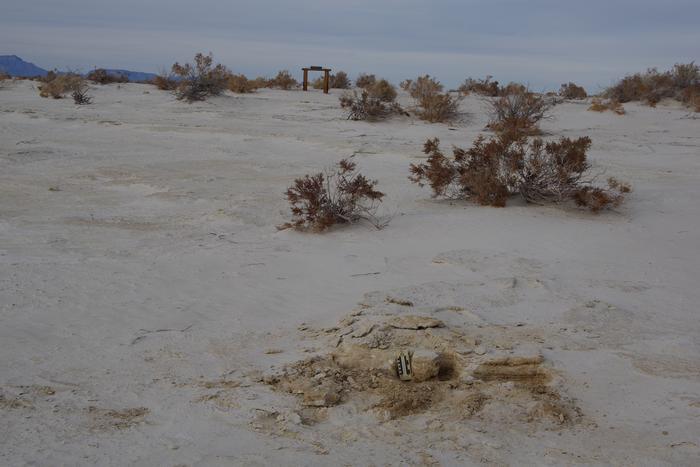
American Association for the Advancement of Science (AAAS)—New research* confirms the hotly contested age of fossilized human tracks found in White Sands National Park, New Mexico. Stratigraphic records corroborate that the footprints range from 21,000 to 23,000 years old, dating to the Last Glacial Maximum (LGM), when a lake and wetlands were present at the site. In 2021, scientists dated fossilized human footprints and trackways found at White Sands to 23,000 years ago. However, the discovery caused controversy because it challenged existing theories of how people first populated North America, suggesting that people migrated before the LGM’s ice blocked the continent from Asia. Researchers argued whether the techniques used – radiocarbon dating of seeds and pollen – had produced accurate and reliable results. Subsequent work in 2023 corroborated the earlier results, but questions lingered. Now, Vance Holliday and colleagues provide even more evidence confirming the age of these human tracks. They independently radiocarbon-dated a variety of materials at new sites associated with the paleo-lake Otero, yielding a newly measured and dated stratigraphy that closely matches the findings of previous work. Notably, these wetland radiocarbon dates came from labs unaffiliated with the original 2021 study, placing humans at the site squarely in the LGM and supporting an early human presence in North America.
_______________________________

The exposure at Gypsum Overlook near the White Sands dunes. The red-brown lenses in the foreground are stream deposits dating ~22,000 years old. They can be traced directly to the stream layers ~1 mile (~1.6 km) away with human footprints of the same age. Above the red-brown layers up to the skyline are thin layers of olive-gray lake clays spanning ~22,000 to ~17,000 years old and representing ancient Lake Otero. Photo by Vance Holliday
_______________________________
Article Source: AAAS news release
*Paleo-lake Geochronology Supports Last Glacial Maximum (LGM) Age for Human Tracks at White Sands, New Mexico, Science Advances, 18-Jun-2025. www.science.org/doi/10.1126/sciadv.adv4951
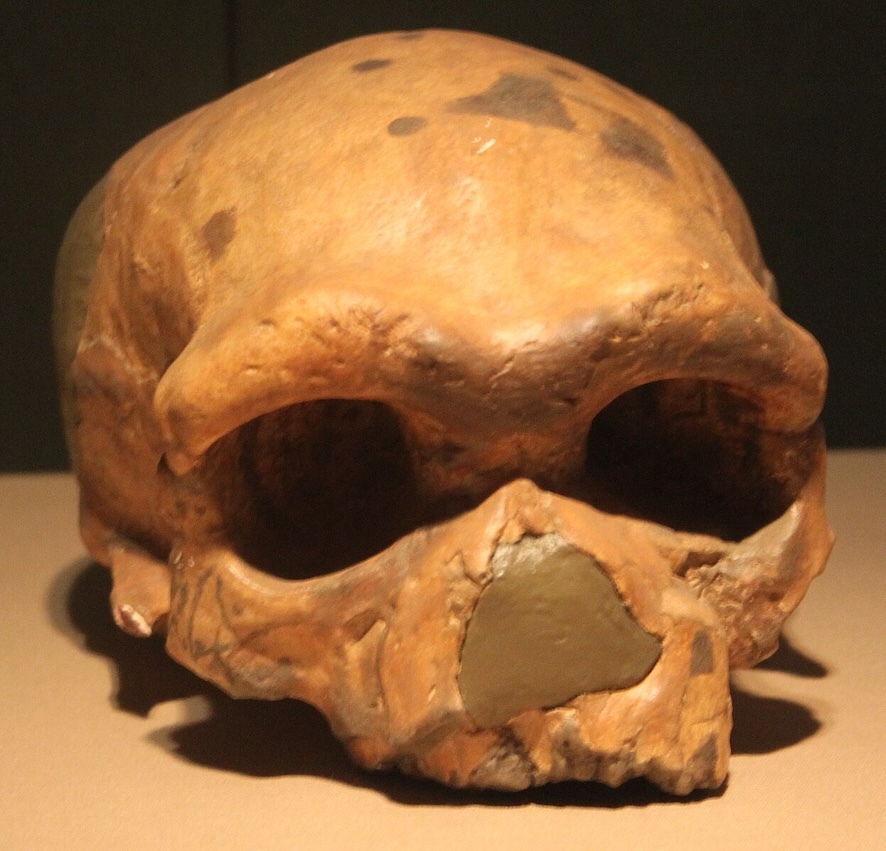
Chinese Academy of Sciences Headquarters—“What Denisovans looked like, despite their genetic contributions to present-day East Asians and Oceanians?” This is one of the most important questions that has arisen since the discovery of the Denisovans 15 years ago.
Now, recent research by a team led by FU Qiaomiei from the Institute of Vertebrate Paleontology and Paleoanthropology of the Chinese Academy of Sciences, and JI Qiang of Hebei GEO University has helped answer this question by confirming that a nearly complete hominin skull discovered near Harbin belongs to the Denisovan lineage. It dates back to at least 146,000 years ago.
The team developed a method for automatic identification of human populations based on ancient proteins, revealing the most informative ancient human proteome to date. They also optimized extraction techniques and developed bioinformatic algorithms to trace the evolution of ancient human DNA from Pleistocene dental calculus, successfully retrieving host mitochondrial DNA from the dental calculus of the Harbin cranium.
These evidences suggest that the Harbin cranium is indeed Denisovan and is linked to the early Denisovan lineage from Siberia. These findings were recently published online in the journals Science and Cell, respectively.
The Harbin cranium, dating back at least 146,000 years, provides crucial insights into the wide distribution of Denisovans in Asia. Prior to this discovery, Denisovan fossils were limited and fragmentary, complicating our understanding of their morphology and evolutionary history. The Harbin fossil, identified as a new species, Homo longi, shares significant morphological similarities with Denisovan remains found at other locations.
The research team conducted independent palaeoproteomic analyses and innovative ancient DNA experiments on the Harbin cranium and its dental calculus. For the first time, their findings conclusively linked the nearly complete skull to the Denisovan population, resolving a question that has persisted since Denisovans were first identified through ancient DNA in 2010.
Using a newly established palaeoproteomic system, the team analyzed mass spectrometric data from the Harbin cranium, identifying over 308,000 peptide-spectrum , more than 20,000 peptides, and confirming 95 endogenous proteins. This extensive dataset surpasses previous results from contemporaneous fossils.
The team also discovered 122 single amino acid polymorphisms (SAPs) unique to Hominidae species, confirming the Harbin individual’s classification within the Homo genus.
Notably, they identified three variants unique to Denisovans, establishing a phylogenetic link between the Harbin individual and Denisova 3.
Despite the challenges of ancient DNA research, the team successfully retrieved mitochondrial DNA from dental calculus samples with a lot of effort. They optimized extraction methods and constructed multiple libraries, ultimately identifying Denisovan-specific mutations for further analysis.
The results confirmed that the Harbin individual belongs to an early mtDNA lineage of Denisovans, suggesting a wide distribution from Siberia to Northeast China during the late Middle Pleistocene. This study highlights the potential of dental calculus for preserving ancient human DNA, opening a new window into the genetic research of Middle Pleistocene hominins.
The two studies not only resolve the classification controversy surrounding the Harbin cranium and reveal the relatively complete skull morphology of Denisovans, but also provide important references for identifying other ancient human fossils in East Asia that may belong to the Denisovan lineage, such as those from Dali and Jinniushan.
____________________________

The Harbin cranium. Gary Todd, CC0 1.0 Universal, Wikimeda Commons
____________________________
Article Source: Chinese Academy of Sciences Headquarters news release
*The proteome of the late Middle Pleistocene Harbin individual, Science, 18-Jun-2025. 10.1126/science.adu9677